Origin of IJN Cruisers: Meiji and Bakumatsu era Frigates:
The origin of Cruiser design in Japan came from the Bakumatsu and Meiji eraso roughly the 1855-1877 period. During that time, marked by deep transformations of the archipelago (notably on the industrial side) and the Boshin war (1868-69), the influence of foreign designs, either Dutch, German, French and later British. But specifically, ships built locally were also often armoured corvettes, rather than frigates (none were in service, but the armoured corvette type was judged superior).
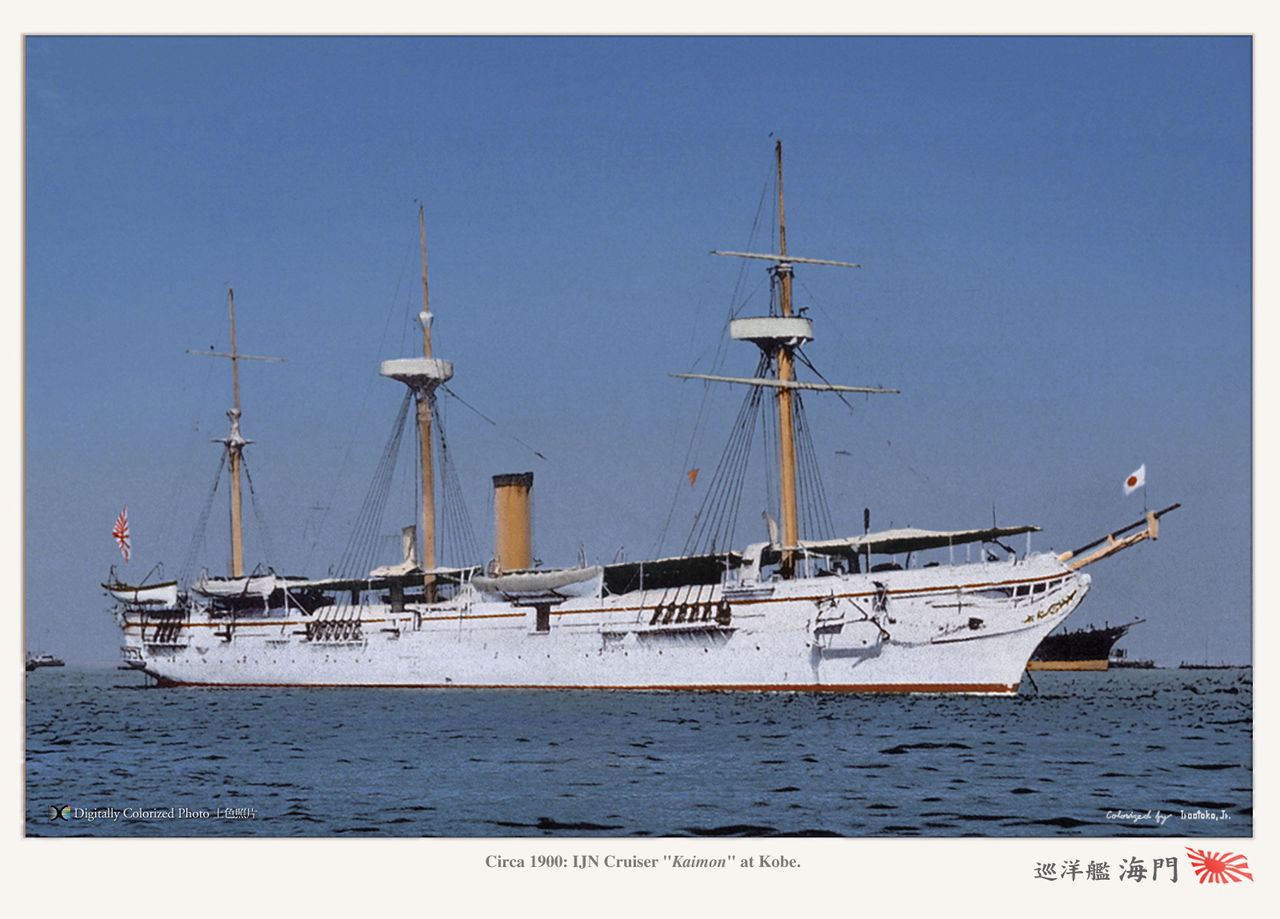
The Kongo (1877) and Kaimon class (1883) were arguably the first “masted cruisers” of the IJN. The first was a composite-hull (IJN Kongo) and the second an iron hulled ship (IJN Hiei) built at Earle’s Sb Co, Hull and Milford Haven Sb co. Pembroke. They displaced 2,200 tons and they were modernized in 1895 after the battle of Yalu. The Kaimon class was a barque-rigged, smaller ship made at Yokosuka Naval Arsenal, with Krupp armament under French supervision. From there, the tiny Imperial Japanese Navy began to seek for engineering expertise; The French answered the call, setup an academy, the first military shipyard, exported the “jeune ecole” theories, and built ships for Japan, locally or in France.
However after 1894, bad experiences with French ideas and designed pushed Japan to the Arms of the United Kingdom, both for constructions and design influences. This was consecrated by an alliance in 1903 and complete shadowing of the Royal Navy methods or training and tactics, mirroring the Prussian influence on the army. Prior to the war with Russia however, amidst growing tension in Asia in the context of the Boxer rebellion, Japan hastily ordered the cruisers which cannot be locally between Yokosuka and Kure. To UK, but also Germany, France, and even Italy, but always with the same British-origin artillery to simplify maintenance, supply and streamline training.
Logically the path followed mirrored many other growing fleets of the time, starting in the 1880s with masted and unprotected cruisers, then protected cruisers, armored cruisers and battlecruisers. There will be a small review of these battlecruisers, although they will be treated more in detail in a Japanese capital ship portal page, which they belongs.
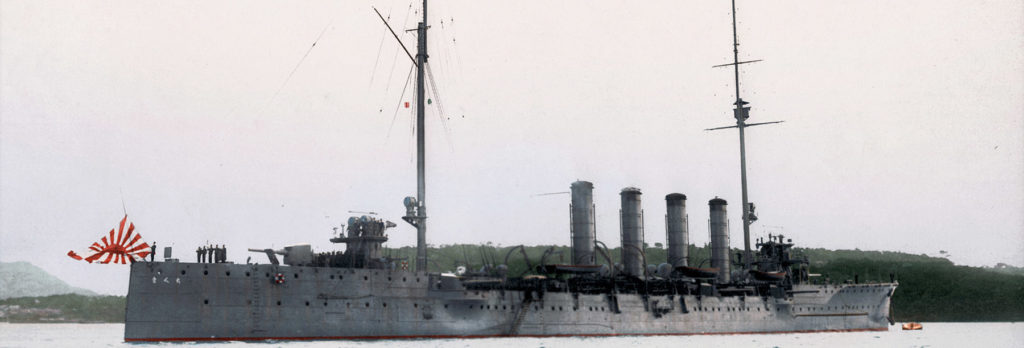
IJN Chikuma, colorized by IrooToko Jr.
Nomenclature of Japanese Cruisers
-Tsukushi unprotected cruiser
-Takao unprotected cruiser
-Yaeyama unprotected cruiser
-Chishima unprotected cruiser
-Tatsuta unprotected cruiser
-Miyako unprotected cruiser
-Chihaya unprotected cruiser
-Tone protected cruiser
-Suma class protected cruisers
-Yodo class protected cruisers
-Chitose class protected cruisers
-Tsushima class protected cruisers
-Akitsushima protected cruiser
-Chikuma class protected cruisers
-Tsukuba class armored Cruisers
-Ibuki class armored Cruisers
-Idzumo class armored Cruisers
-Kasuga class (Italian-built)
-Adzuma armored Cruiser
-Asama armored Cruiser
-Yakumo armored Cruiser
-Chiyoda armored Cruiser
-Kongo class battlecruisers
However the first “proper” cruiser, designated as such was the IJN Tuskushi, laid down at Elswick in October 1879. This unprotected cruiser, typical of Edward Reed designs for export cruisers was similar to the Chinese Tchao Yung class and maid for Peru initially. Displacing 1350 tonnes, she was armed with two 10-in guns and four 4.7 in guns, two 9-pdr plus 1-pdr Hocthkiss QF guns. She was a TS in 1907 and scrapped in 1910.
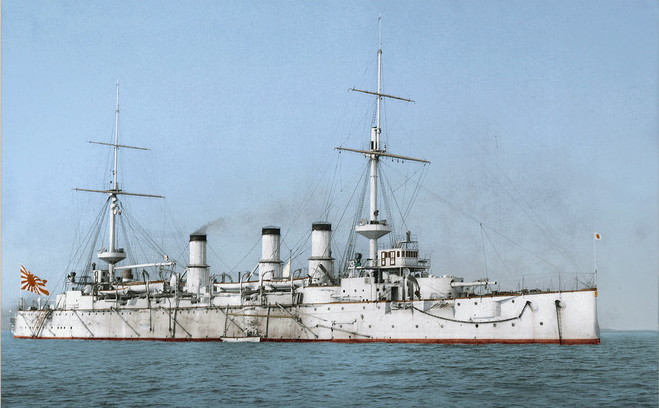
IJN Adzuma in 1900
More interesting was the first cruiser built in Japan, IJN Takao.
She was laid down at Yokosuka NyD,setup by the French mission of engineer Emile Bertin in October 1886. This 1750 tonnes vessels was armed with German Krupp guns and had two quad barrel Nordenfelt MGs. She never saw WW1 on the frontline, retired in 1911 and survey ship until 1918, when she was sold. New was IJN Yaeyama, also built in the same yard and launched in 1889. She was refitted for tests after the Russo-Japanese war and scrapped in 1911.
Next, IJN Chishima was built in France, a 741 tons unprotected cruiser. This very frail ship was lost in a collision with the British steamer Ravenna soon after entering service. This, added to the loss of IJN Unebi, a much costlier and larger protected masted cruiser en route to Japan, made the naval staff weary of French designs. Just as a war with China seemed inevitable, the Government ordered to Elswick the Tatsuta, but she was interned en rout in Suez and delivered only in 1896. She served in WW1. Japan’s last unprotected cruisers were IJN Miyako built in Kure, brand new facility and naval yard in 1894-99 and IJN Chihaya (1900) in Yokosuka. Only the later saw WW1, IJN Miyako hit a mine in front of Port Arthur during the war and sank with all hands.
From there, the path was logical, with protected cruisers developed in parralel -the first were IJN Naniwa and Takachiho, White’s design export cruisers in 1885- and armoured cruisers with IJN Chiyoda, a British-built replacement for the ill-fated Unebi. This was the most dynamic development branch, until the genre faded out with the launch of HMS Dreadnought; IJN Ibuki, the last of this lineage, was already a semi-battlecruiser. Before the 1911-1925 “light cruisers”, which performed reconnaissance, convoy escort and attacks and conducted destroyer squadrons became the main path of development, before the Washington treaty came out. After this, Japan jumped into the heavy cruiser bandwagon, only following a particular path of extreme displacement reduction.
Japanese Unprotected cruisers (1880-1900)
IJN Tsukushi (1880)
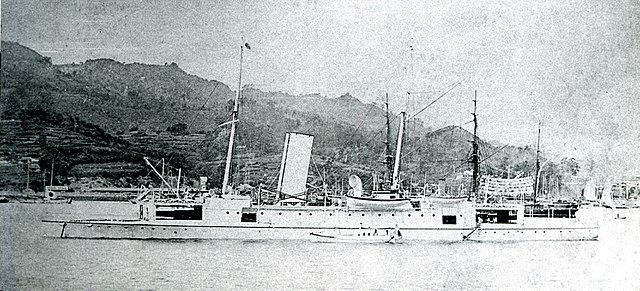
IJN Tsukushi originated in an other order, to British naval architect Sir George Wightwick Rendel of the Armstrong Whitworth shipyards (Newcastle upon Tyne). The company launched to its own expanse a low-cost cruiser able to deal with Ironclads, relying on a low silhouette and high speed plus a high muzzle velocity QF main battery. This was very close to principles of Jeune Ecole promoted by French naval architect Émile Bertin in Japan.
However Royal Navy was wary of its small size for the north sea and did not ordered any. The Yard turned to arms dealers which found Chile as a buyer, as Capitan Arturo Prat. Laid down on 10 February 1879 and launched 11 August 1880 the purchased failed whole the ship was still in completion and she was resold to Japan. First true cruiser of the Empire of the rising sun, this ship however was obsolete within ten years, wit progresses in naval artillery. It had both a weak armor and light guns.
An all-steel construction, waterproof bulkheads, single funnel and twin masts able to carry some rigging and with a reinforced prow for ramming, this small unprotected cruiser was a versatile one. Technical innovations included a hydraulic steering system, electrical lighting, and two breech-loading 10-inch Armstrong Whitworth cannons foward and aft in stationary gun shields. IJN Tsukushi missed the First Sino-Japanese War, patrolling off Korea, but provided fire support during the Battle of Pyongyang. In 1898, she was reamed with modern 120 mm QF guns and redesignated first-class gunboat. She saw service in the Boxer Rebellion and in 1905, and was scrapped five years later.
Specifications
Displacement: 1350t
Dimensions: 64 x 9.7 x 4.4 m
Propulsion: 2 shafts RSE, 4 boilers, 2887 cv. and 16.5 knots max.
Armor: max. 20 mm
Crew: 186
Armament 2 x 254, 6 x 120, 10 x 9-pdr, Hotchiss 1-pdr gun, 2 TT 450 mm.
IJN Takao (1888)
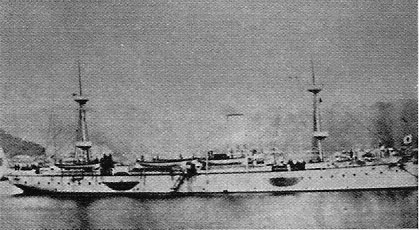
This small cruiser was built in Japan, at Yokosuka NyD, the first IJN cruiser built locally under supervision of French military advisor and engineer Émile Bertin. Components were imported from overseas, this was merely an assembly. It was one step in an approach to export Bertin’s Jeune Ecole naval strategy in Japan. She was later reclassified as classified corvette and gunboat in the literrature after some time and her roles included dispatch vessel.
Takao had a steel-ribbed hull, retaining a full barque rigging on two masts and double-expansion reciprocating steam engine with coal-fired boilers and ingle funnel. Innovation consisted in a double hull amidships and Japanese-built torpedo launchers. Armament was ordered in Germany, four 15 cm (5.9 in) L/35 Krupp guns (sponsons), a stern-mounted british QF 4.7 inch Gun Mk I–IVs gun and a single French QF 6-pounder Hotchkiss gun plus quadruple swedish 1-inch Nordenfelt guns. The torpedo tubes were mounted on the deck.
IJN Takao participated in the Sino-Japanese war of 1894, patrolling, covering convoys and landings near Port Arthur. She was completed on 16 November 1889. First commander was Count Yamamoto Gonnohyōe, not related to Isoroku. Modernized in 1900 she received a new armament and her rigging was cut down. She also fought at Tsushima.
Specifications
Displacement: 1750t
Dimensions: 69.9 x 10.4 x 3.9 m
Propulsion: 2 shafts RSE, 5 boilers, 2330 ihp and 15 knots max.
Armor: 120 mm
Crew: 310
Armament: 4 x 150, QF 4.7 in, 6-pdr, 4 x 45, 2×4 Nordenfelt, 2 x 356mm TTs.
IJN Yaeyama (1889)
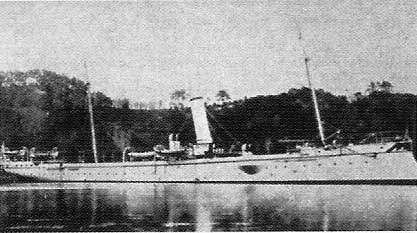
Also laid down at Yokosuka, but in June 1887. She was designed by French military advisor Emile Bertin, as a 1584 tonnes 97 m vessel and light armament comprising 4.7 in (120 mm) guns. Machinery as artillery were imported from Great Britain. Yaeyama was powered by two shaft reciprocating steam engines, triple-expansion (HDA) fed by six (later eight Niclausse 1902; two funnels) boilers rated for 5630 shp. This allowed her to reach 20-3/4 knots, good performances for the 1880s and reflected the Jeune Ecole philosophy.
She has a single funnel and two masts which could receive a schooner rigging. She was the second domestically-produced steel-hulled vessel in Japan also. The armament was fast-firing, with sponsons and a deck gun, completed by two TTs. She participated to the First Sino-Japanese War, and covered landings during the Battle of Weihaiwei. In 1895 she provoked a diplomatic incident during the invasion of Taiwan, shelling the merchant ship SS Thales in International waters. She also took part in the multinational fleet deployed during the Boxer Rebellion, and the 1905 Battle of Port Arthur and blockade. She was modernized again afterwards until 1908 and used as a test ship for oil-fired boilers until stricken and BU in 1911.
Specifications
Displacement: 1584t standard
Dimensions: 95 x 12.30 x 4.6 m
Propulsion: 2 shafts TE 5630 hp. 20,6 knot.
Armor: None.
Crew: 310
Armament: 3 x 120, 8 x 3-pdr, 2 x 457 mm TTs.
IJN Chishima (1890)
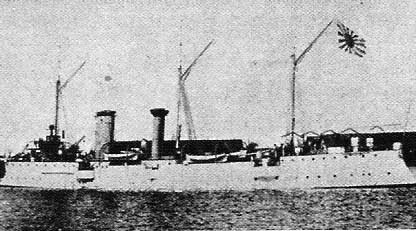
Ordered on the 1882 programme, IJN Chishima (lit. ‘thousand islands’ in ref. to the kuriles) was built in France, at St Nazaire Yards in Britanny. She was laid down in January 1890, launched on November that year and completed in April 1892. The lenghty completion was because of delays cause by unsufficient speed. Designed by Emile Bertin, Chishima could not reach the promise and contracted 22 knots but only 19 and the Yard struggled but failed to achieve one more knot. The was financial compensation by the French government.
She was light, narrow and small, 74 m long for 7.7 wide and 741 tonnes, and designed to serve as aviso in the French way, dispatch vessel. In this guise she was soon obsolete as wireless telegraphy became widespread. She was small enough also to serve as torpedo gunboat. She was armed with two 76 mm (3 in) guns in sponsons either side, with another in the bow. This was completed by six 37 mm (1.5 in) Hotchkiss QF 1-pounder guns in pairs on the bridge, aft deck and sides. Three to five torpedo tubes were also individually mounted on the deck (depending on sources).
Her service was short. She came from St Nazaire through the Suez canal and 30 engineers on board as she displayed an array of technical problems, boiler failure, leaks, and ruptured steam lines.
She collided with the steamer SS Ravenna only one week after commission in the inland sea in the night of 30 November 1892 and sank with all hands. A maritime tribunal held by the British consular court in Kobe cleared P&O. Apparently she was cut in two whereas Ravenna had only minor damage, this was attributed to the frail construction. The tragedy led Japan to institute Maritime Anti-Collision Regulations.
Specifications
Displacement: 741 tonnes standard
Dimensions: 71 x 7.7 x 2.97 m
Propulsion: 2 shafts reciprocating VTE, 5000 ihp, 19 knots.
Crew: 310
Armament: 5 x 3in (75mm), 6 x 1pdr, 3 x 15-in TTs.
IJN Tatsuta (1894)
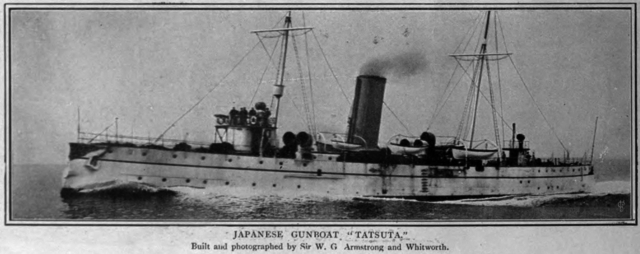
The wind changed in the 1890s as Japan closed to UK for shipbuilding after French mishaps. Tatsuta was ordered to Armstrong Whitworth. Steel hull, full barque rigging, two masts, auxiliary sail propulsion. She carried two QF 4.7 inch Gun Mk I–IVs guns, four QF 3 pounder Hotchkiss guns, five 2.5-pounder guns, five torpedo tubes on the deck.
When the First Sino-Japanese War broke out, she was transiting to Aden. Due to neutrality issues, on 28 August 1894 she was interned there. She was released on 19 March 1895 after the war was over and arrive in Japan to be commissioned re-classified as a dispatch vessel. She carried out missions of escorts and patrols and covered landings during the Boxer Rebellion. She was overhauled afterwards in 1902 at the Kure Naval Arsenal, with a modernized armament and new Niclausse water-tube boilers. During the Russo-Japanese war she rescued crews of the Yashima and Hatsuse hit by mines. In 1912, Tatsuta was re-classified as a 1st class gunboat, and discarded in 1916.
Specifications
Displacement: 650t
Dimensions: 77.1 x 8.38 x 2.9 m
Propulsion: 2-shaft recip. VTE, 5,069 ihp (200 tons coal)
Crew: 100-120
Armament: 2 x 4.7 in QF (120mm), 4 x 3pdr, 5 x 18-in (457 mm).
Miyako (1898)
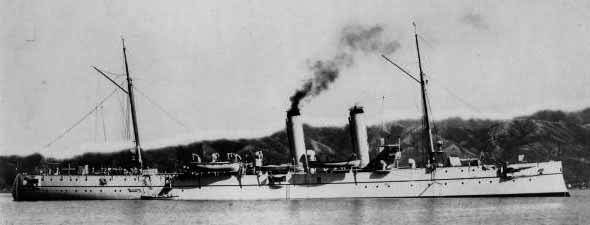
Miyako was designed under the supervision of Émile Bertin, built at the Kure Naval Arsenal, the first built there. This small crusier had powerful engines, which were able to deliver a 20-knot (37 km/h) speed. It was lightly armed and classified as a corvette or gunboat. She was very close to the unprotected cruiser Milan (1885), with a steel hull, two masts for a schooner rigging, two QF 4.7 inch Gun Mk I–IVs guns, eight QF 3 pounder Hotchkiss guns and two decks torpedoes.
Completed on 31 March 1899 she missed the Sino-Japanese War and until October 1902 served under the Commander Yashiro Rokurō. She participated in the Russo-Japanese War, naval Battle of Port Arthur and blockade, under Tochinai Sōjirō. She made a reconnaissance of Dairen Harbor before landings of 2nd Army IJA, but struck a mine, sinking within minutes during the night of 14 May 1904, sinking slowly eshe “only” lost two crewmen. She was discarded on 21 May 1905, sold for BU on 4 July 1906.
Specifications
Displacement: 1772t
Dimensions: 95,7 x 10.4 x 4.6 m
Propulsion: 2 shafts 6130 tonnes ihp. 20 knots.
Crew: 200
Armament: 2 x 4.7 in (120), 8 x 3-pdr, 2 x 18-in TTs (457 mm).
IJN Chihaya (1900)
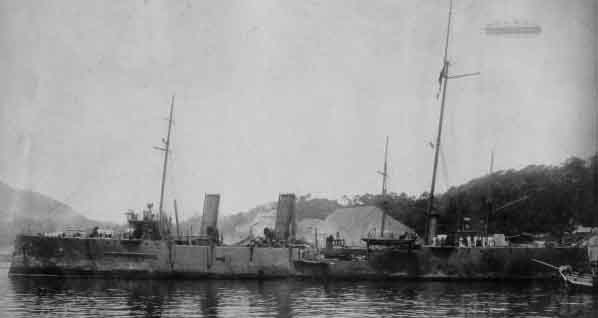
IJN Chihaya was based on another dispatch vessels design by Emile Bertin. She was laid down at the Yokosuka Naval Arsenal. She was therefore used as a dispatch boat, as for for scouting, reconnaissance. She was completed on 9 September 1901. She measured 83.19 m (272.9 ft) x 9.63 m (31.6 ft) x 3.35 m (11.0 ft) in draft. Built with a steel hull, she was barque-rigged with two masts, one funnel. She also had 2-shaft reciprocating VTE, which developed 6,000 ihp (4,500 kW) with 6 boilers and carried 344 tons of coal and carried two QF 4.7 inch Gun Mk I–IVs in sponsons, four QF 3 pounder Hotchkiss guns and deck torpedo tubes.
She collided off Tateyama, Chiba with the destroyer Akebono during sea trials, before commission, on 9 September 1901. She participated in the naval Battle of Port Arthur and blockade, took part in the Battle of the Yellow Sea and Battle of Tsushima, leading destroyers which later finished off the Knyaz Suvorov. She was reclassified as a first-class gunboat in 1912, and patrolled former German Micronesia in August 1914. In 1918-1923, she provide support for the Japanese intervention in Siberia in support of the White Russians. In 1928 she was transformd as a training vessel at the Yokosuka Naval Arsenal and served as a training hul at the Imperial Japanese Naval Academy until 1939, apparently still afloat in 1945. Quite a career for this ship.
Specifications
Displacement: 1258t
Dimensions: 83.19 x 9.63 x 3.35 m
Propulsion: 2 shafts VTE 6000 ihp, 6 boilers, 344 tons coal, 21 knots max.
Crew: 125
Armament: 2 x 4.7-in (120 mm), 4 x 3-pdr, 2 x 381 mm TT.
Japanese Protected cruisers
Unebi (1897)
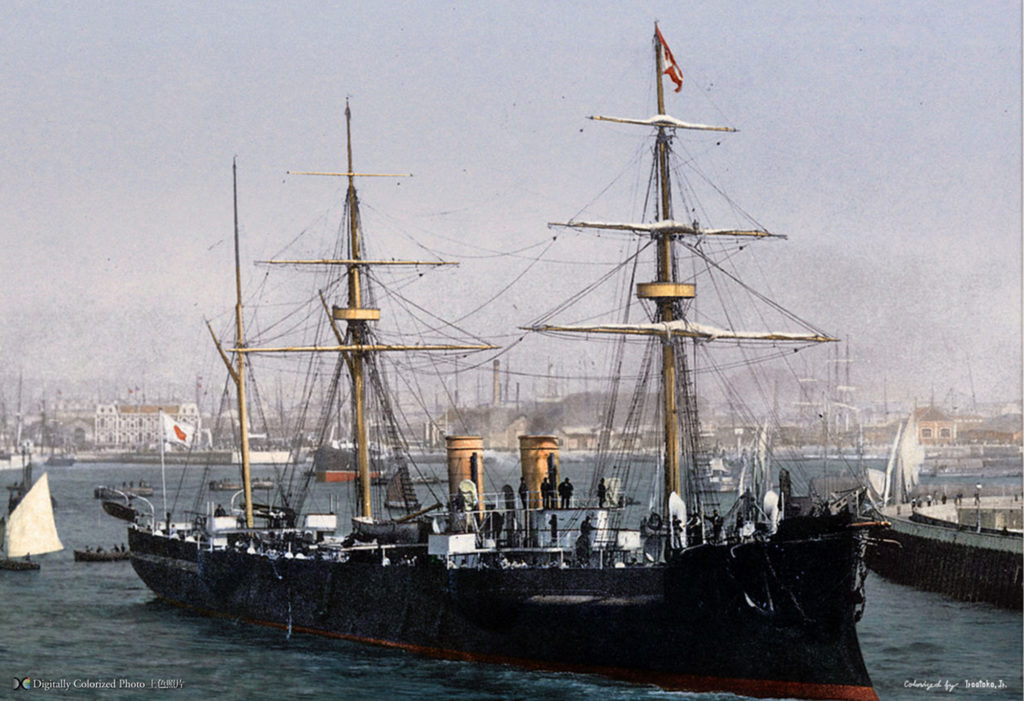
As the admiralty faced with the Chinese threat, notably the mighty Beiyang fleet, seeked to acquire ships in the West less costly than British battleships, the French mission and its engineer Emile Bertin spread the Jeune Ecole theories to some attentive ears.
As armoured cruisers seemed a sound design type, the Japanese admiralty through Naval Minister Kawamura Sumiyoshi obtained an order at Forges et Chantiers de la Gironde (Bordeaux) in France of such a cruiser FY1883, laid down 17 May 1884 (alongside two British cruisers). Launched by 6 April 1886, Unebi was completed in October 1886 but lost after just two month after completion en route to Japan.
She even never saw any home port of her intended customer. Needless to say an enquiry took place, which eventually concluded that the choice of having four heavy 10 inch gun Mk I/IV guns in sponsons, the design of the hull, combined to the tall masts and superstructures.
Most authors agreed that she was believed to be top-heavy, high and unstable, a perfect recipe for disaster when a cyclone hit her in 1886. The most immediate consequence after obtaining compensation from the yard, was to never order an ship in France again, to the exception of IJN Adzuma (1899) built in St Nazaire.
Suma class (1895)
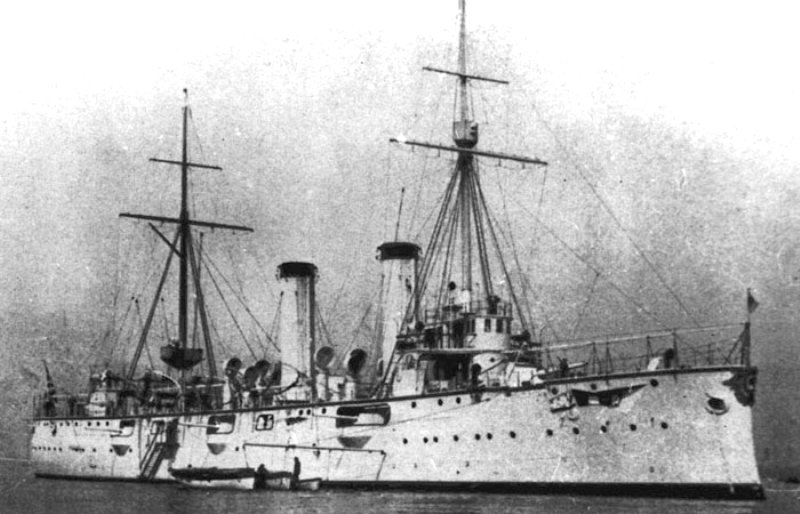
The Suma and the Akashi will be the first fully Japanese cruisers (design and construction), since they were made at the Yokosuka shipyards from 1892 to 1896 for the first and from 1894 to 1899 for the second. Only the cannons (Armstrong) were not local.
They were however inspired by the Akitsushima for many aspects, even in the choice of machines and heavy military masts. They inherited the same faults and were later modified in the same way, receiving new boilers and light masts to improve roll stability.
In addition, the Suma was reputed to mishandle the side blades and this defect was corrected on the Akashi then in completion which received a hull with bulwark without detachment. The two ships were engaged during the Russo-Japanese War, Akashi undergoing the impact of a mine but was repaired and participated like its twin in the great war. They were decommissioned in 1922 and experienced a long period of inactivity, the Suma being delivered for demolition in 1928 and IJN Akashi ending his career as a target ship in 1930.
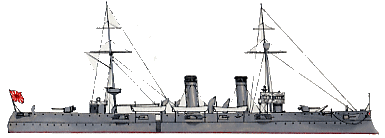
Author’s rendition of the IJN Suma
Specifications
Displacement & Dimensions 2657t; 95 x 12.30 x 4.6 m
Propulsion 2 propellers, 8500 cv. and 20 knots max.
shielding, max. 120 mm; Crew 310
Armament 2 guns of 152, 6 of 120, 10 of 47, 4 of 45, 4 mitt. Maxim, 2 TLT 381mm sides.
Chitose class (1895)
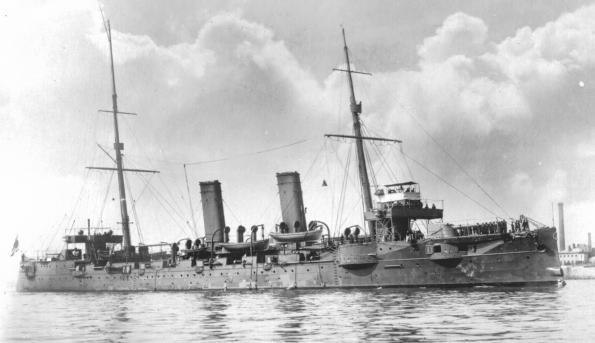
The IJN Chitose and IJN Kasagi were built in the USA, at Union Works shipyards in San Francisco and at Cramp in Philadelphia. These were enlarged versions of the Takasago built in Great Britain. They served during the Battle of the Yellow Sea and at Tsushima, being hit hard. The Kasagi was used from 1910 as a training ship and was lost on reefs in 1916 in the Tsugaru Strait, and the Chitose served as coast guard from 1922, before being struck off the lists in 1928 and end his days as an exercise target in 1931.
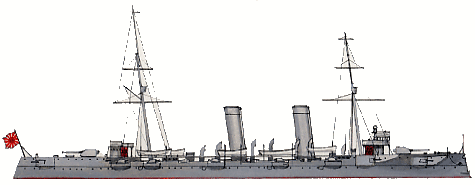
Author’s rendition of the Chitose
Specifications
Displacement & Dimensions 5700t; 120 x 14.9 x 5.4 m
Propulsion 2 propellers, 15,000 hp. and 22.5 knots max.
shielding, max. 120 mm; Crew 434
Armament 2 guns of 203, 10 of 120, 12 of 76, 6 of 45mm, 4 TLT 457mm sides, front and rear.
Tsushima class (1902)
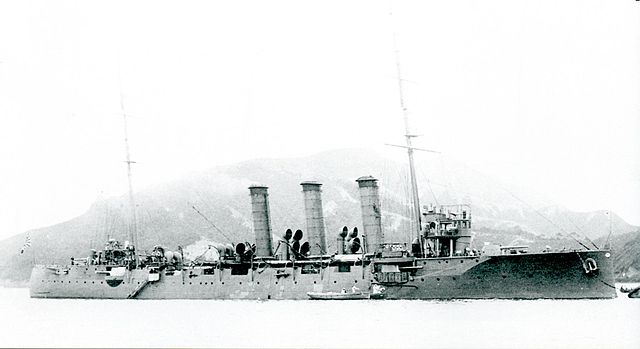
IJN Tsushima and IJN Niitaka, entirely designed and built in Japan, followed the Suma class and took note of their many flaws. They benefited from a particular attention paid to stability, their 8-in guns being thus better distributed, placed lower in order to better balance the point of gravity. in addition, they sported from the start of the light masts and had more efficient Niclausse boilers. Their active life was quite long: They distinguished themselves during the Russo-Japanese War, then freshly put into service (Jan-Feb 1904). They served during the war grade but the Niitaka sank in 1922, victim of a typhoon on the coast of Kamchatka. The Niitaka at the same period was partially decommissioned in 1922, and again in 1930. It served until 1936 as a training ship, before being completely decommissioned in 1939 and definitively struck off the lists. Its hull was sunk by American aviation in 1944.
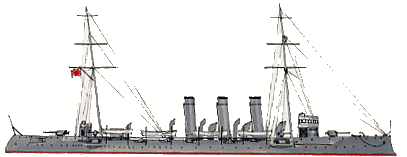
Author’s rendition of the IJN Tsushima
Specifications
Displacement & Dimensions: 3366t FL, 106 x 13,4 x 5 m
Propulsion: 2 shaft VTE, 9500 shp. et 20 kots max.
Armor: 102 mm
Crew: 320
Armament: 6 x 152, 10 x 76, 4 x 45 mm guns.
Akitsushima (1892)
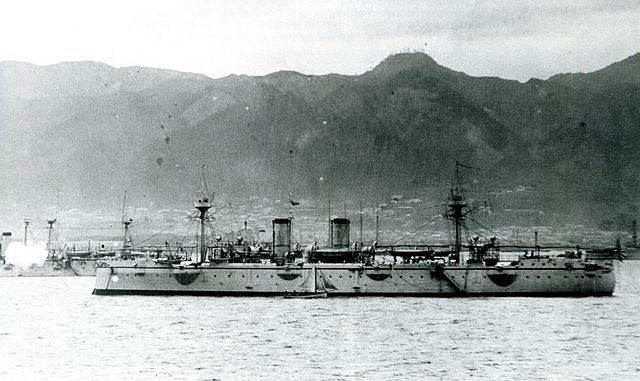
Built in Yokosuka, this cruiser was inspired by the American Baltimore as well as by William White’s plans at Armstrong. It was not very successful, showing too much roll, and quite slow. He nevertheless participated in the Battle of Yalu, sinking with the Naniwa the Chinese cruiser Kuang Chi, then in the Russo-Japanese War, and finally in the Great War, before being disarmed in 1921 and BU 1923.

Author’s rendition of the Akitsushima
Specifications
Displacement & Dimensions 3100t; 91 x 13.14 x 5.3 m
Propulsion 2 propellers, boilers, 8400 hp. and 19 knots max
Armor: 115 mm
Crew: 330
Armament: 4 guns of 152, 6 of 120, 8 of 47 mm, 4 TLT 456 mm sides.
Chikuma class (1911)
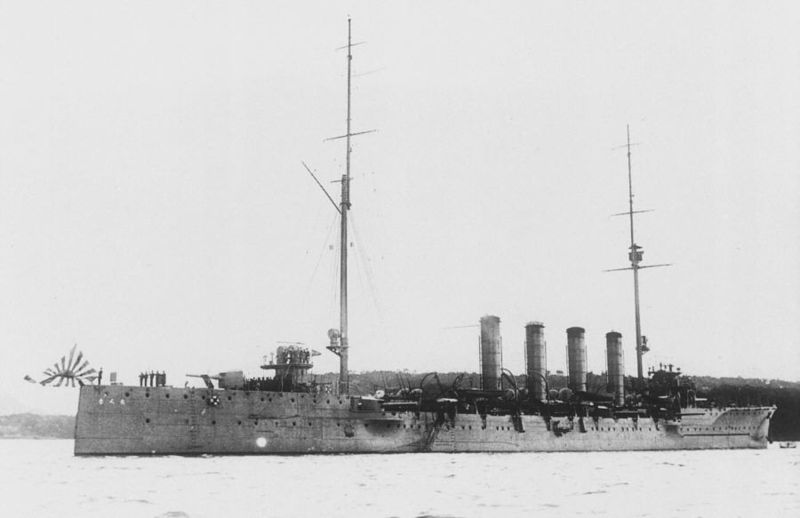
IJN Chikuma, Yahagi and Hirado were built in Sasebo, Mitsubishi and Kawasaki respectively and completed in 1912. They were much improved versions of the Tone (1907). Their main characteristic was a very homogeneous “monocaliber” armament, like the contemporary British cruisers. They participated in the operations of the great war, the Chikuma being part of the allied hunting fleet against Count Von Spee. He was struck off the lists in 1931, and in 1940 for the other two. However the Hirado was kept in reserve until 1947, as was the Yahagi, renamed and used as a training ship within the Imperial Japanese Naval Academy at Eta Jima.

Author’s rendition of the Chikuma class
Specifications
Displacement: 5040t
Dimensions: 145 x 14.2 x 5.1 m
Propulsion: 2 shafts turbines, 16 Kampon boilers, 22,500 hp. 26 knots max.
Armor: 102 mm
Crew: 414
Armament: 8 x 152, 4 x 78, 2 x 7.62mm AA, 3 x 457 mm Sub TT.
Japanese Armoured cruisers
Tsukuba class armored cruiser (1905)
The Tsukuba and Ikoma were two armored cruisers armed with 12-in (305 mm) artillery turrets, as a result of a request from the navy after the observation of long-range shots by the Russians during the battle of the Yellow Sea, and in replacement of the Hatsuse and Yashima, having jumped on mines in Port Arthur. At their completion, after rapid construction (too much, given the defects noted later), they were too slow and above all too weakly armed to be compared to their European equivalents, but were still classified as such by the General Staff.
During the great war, on January 14, 1917, the Tsukuba suffered a violent accidental explosion of one of its ammunition bunkers which tore its sides, making 305 victims. It sank on the shoals of Yokosuka Bay and was later bailed out and demolished. The Ikoma became in 1919 a training ship for gunners, being refitted with 10 pieces of 152, 8 of 120 and 6 of 45 mm. He was struck off the lists in 1924, after only 16 years of working life.
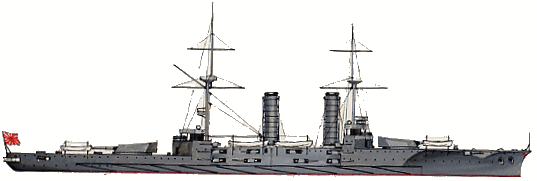
Author’s rendition of the IJN Tsukuba
Specifications
Displacement: 15,400t FL
Dimensions: 137.2 x 23 x 8 m
Propulsion: 2 shafts, 20 Miyabara boilers, 20,500 hp. 20.5 knots
Crew: 844
Armament: 4 x 305, 12 x 152, 12 x 120, 4 x 45 mm, 2 x 40 mm AA, 3 x 457mm TTs.
Ibuki class armored cruiser (1905)
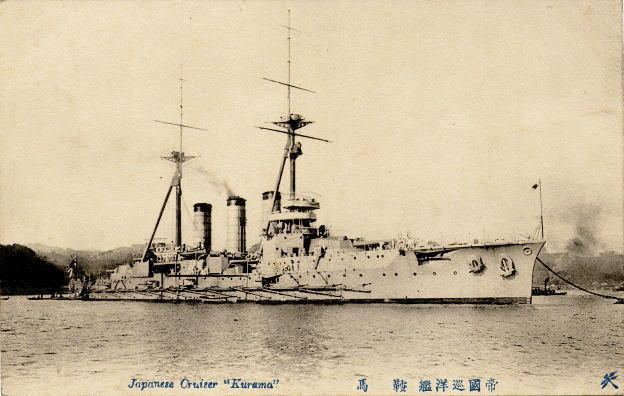
IJN Kurama circa 1925 – postcard
The Ibuki and the Kurama, built respectively in Kure and Yokosuka, were derived from the previous Tsukuba. They did not differ in size but in their turbines, a first for Japanese ships, and their armament reinforced with 203 mm pieces. In addition, the two units differed from each other, the Ibuki having lower funnels and simple masts, but also turbines bringing total power to 24,000 hp against 22,500 and 21.5 knots against 20 on the Kurama equipped with machines standard. The two did their service during the Great War. IJN Ibuki participated in the hunt for Von Spee’s squadron before escorting Anzac convoys to the Dardanelles front via Suez. They were disarmed in 1924-25 and struck off the lists.

Author’s rendition of the IJN Ibuki
Specifications
Displacement: 15,595t FL
Dimensions: 137.2 x 23 x 8 m
Propulsion: 2 shaft, 20 Miyabara boilers, 22,500 hp. 20.5 knots.
Crew: 844
Armament: 4 x 305, 8 x 203, 14 x 120, 4 x 45 mm, 3 x 457mm TTs.
Idzumo class (1899)
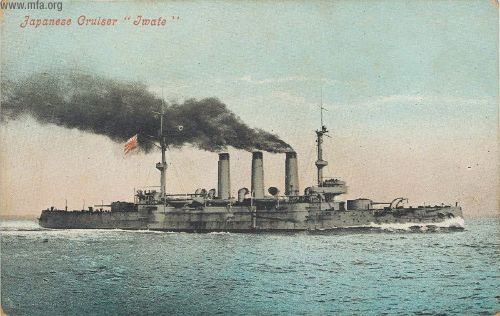
Armoured cruiser IJN Iwate
The Idzumo and the Iwate will be the last armored cruisers built in Great Britain. Close to the Asama built a year earlier, they were also very similar, differing only in their three funnels. their armaments were distributed in the same way, and their armor was identical. their main internal difference concerned the machines, adopting 12 new, much lighter Belleville boilers. The weight saved went into the reinforcement of the more solid Krupp steel alloy armor. The two participated in operations during the Great War and were partially disarmed in 1922, receiving new machines. They served as training ships until 1945, both sinking victims of an air raid on the Japanese coast before being scrapped in 1947.

Author’s rendition of the IJN Idzumo
Specifications
Displacement & Dimensions 9750t; 132 x 21 x 7.4 m
Propulsion 2 propellers, 14,500 hp. and 20.75 knots max.
Armor, max crew 356 mm; Crew 672
Armament 4 guns of 203, 14 guns of 152, 12 of 76, 8 of 47, 4TLT 457 mm sides.
Kasuga class (1902)
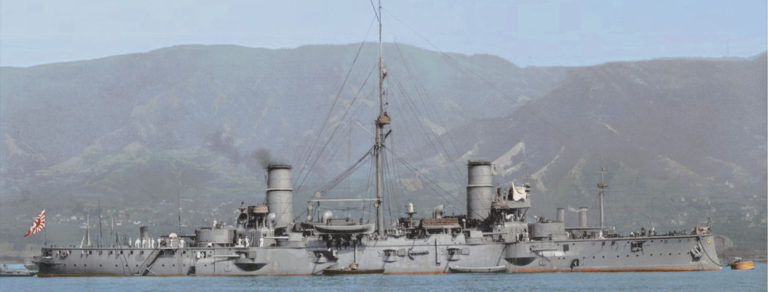
The Kasuga and the Nisshin were the only ships purchased indirectly from the Italians. They were built in Ansaldo as true copies of the Garibaldi and for the service of the Italian Navy as fifth and sixth in the class, Mitra and Roca. Argentina then at war with Chile bought them under construction and they were renamed Rivadvia and Moreno. But hostilities ceased at their end, so that Argentina sought a new buyer for these supernumerary units. The Japanese who wanted to counter the Russian threat of the Pacific presented themselves.
These two ships, completed in January 1904, were well armed but less well protected and served during the Russo-Japanese War with just trained crews, being present at the Battle of the Yellow Sea and at Tsushima where the Nisshin was badly damaged. they also served during the Great War, sent to the Mediterranean. They were disarmed in 1922 and used as training ships. The Kasuga survived the Second World War in this role, while the Nisshin ended his career in 1936 as an exercise target.
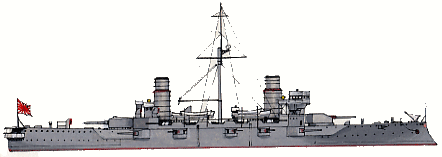
Author’s rendition of the IJN Kasuga
Specifications
Displacement & Dimensions 7630t; 111.72 x 19 x 7.3 m
Propulsion 2 propellers, 13,500 hp. and 20 knots max.
Armor, max crew 152 mm; Crew 600
Armament 1 gun of 254 mm, 2 of 203, 14 of 152, 10 of 76, 6 of 47, 2 mitt. Maxim, 4TLT 457 mm lat.
Adzuma (1899)
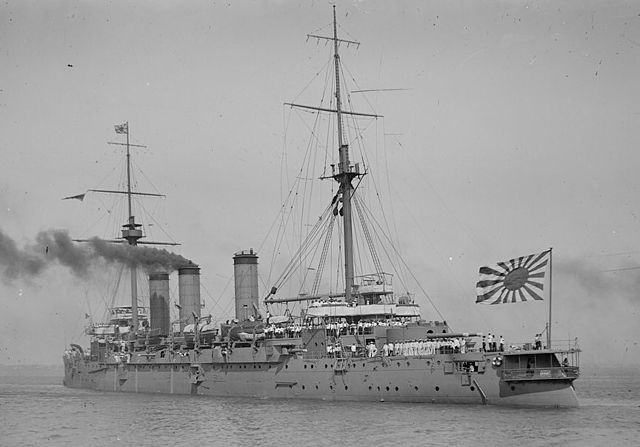
The Adzuma was built in France, in St Nazaire. It was less well protected than British ships, but that did not benefit its speed, which with less power, remained limited. She participated in the Russo-Japanese War and served as a training ship in 1914. She was decommissioned in 1921, placed in reserve, and completely in 1941. In 1945 she was badly damaged by US navy aircraft and BU. This is a very short overview, like the other armoured cruisers, and of course each will be covered by a specific, dedicated post.

Author’s rendition of the Adzuma class
Specifications
Displacement & Dimensions 9307t; 138 x 20.94 x 7.2 m
Propulsion 2 propellers, 12 boilers, 17,000 hp. and 20 knots max.
Armor, max crew 356 (blockhouse), elsewhere 152 mm; Crew 650
Armament 12 guns of 203, 12 of 152, 12 of 76, 12 of 47 mm, 5 TLT 457mm SM.
Asama (1899)
The Asama and the Tokiwa were built at the Armstrong Elswick yards between 1896 and 1899. It was the “export” design by Philipp Watts, and they were very similar to the Chilean O’Higgins. Homogeneous and well balanced, they were quite successful. They had a long career, both participating in the Battle of Tsushima, receiving fairly serious damage. Repaired, they served during the great war. In 1923 their fate was sealed but the Asama was partially decommissioned and used as a training ship while the Tokiwa was converted into a minesweeper. It was partially rebuilt to take away 300 mines. In 1927 he suffered an accidental mine explosion, and was placed in reserve. it resumed service during the Sino-Japanese War of 1937, rebuilt to be able to carry 500 mines, and seeing its AA armament reinforced. it was hit by a mine in 1945, then sunk by American aviation. The Asama was not demolished until 1947.
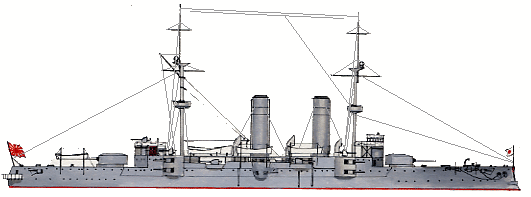
Author’s rendition of the Asama
Specifications
Displacement & Dimensions 9700t; 135 x 20.45 x 7.4 m
Propulsion 2 propellers, boilers, 18,000 hp. and 21.5 knots max.
shielding, max. 152 mm; Crew 726
Armament 4 guns of 203, 14 guns of 152, 12 of 76, 7 of 45mm, 5 TLT 457mm sides and prow.
Yakumo (1899)

Being one of the rare Japanese ships to have been built in Germany, the Yakumo however had no characteristic features of its Germanic equivalents. Its protection was even better and its general architecture earlier British. Its artillery did not come from Krupp but Armstrong Elswick, a requirement of compatibility with the equipment of the rest of the fleet. During the Battle of Tsushima, the Yakumo contributed greatly to the destruction of Admiral Ushakov. She was partially decommissioned in 1921, serving as a training ship, and receiving new Yarrow boilers. He survived in this role until 1947.
Specifications
Displacement & Dimensions 9646t PC; 125 x 19.5 x 7.25 m
Propulsion 2 propellers, 15,500 hp. and 20.5 knots max.
shielding, max. 356 mm; Crew 700
Armament 4 guns of 203, 12 of 152, 12 of 76, 7 of 45 mm, 5 TLT sides and prow.
Chiyoda (1890)
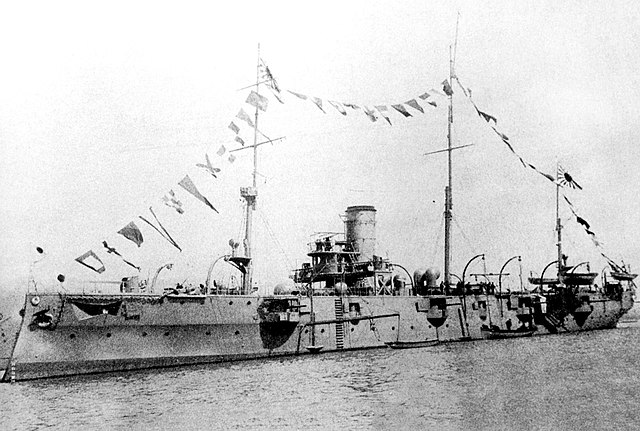
Built at John Brown in England, the Chiyoda was the first Japanese armored cruiser. She replaced the Unebi lost in a typhoon in 1887. The Japanese by then were disappointed with French designs and turned to their battleship supplier. Its homogeneous 5-in (120 mm) battery seemed modest but it was very well organized, with a considerable rate of fire and cross-firing range without blind spot.
It also included 84 watertight compartments. However its initial locomotive boilers proved disappointing and its too heavy armored masts impaired its roll stability and were replaced. He thus participated in the Battle of Yalu during the Sino-Japanese War, then in the Russo-Japanese War, and in the Battle of Tsushima although he had struck a mine a few months earlier. In 1921 it became a deposit ship and in 1922 it was struck off the lists, demolished in 1927.
Specifications
Displacement & Dimensions 2400t; 95 x 13 x 4.3 m
Propulsion 2 propellers, 5600 hp. and 19 knots max.
shielding, max. 110 mm; Crew 350
Armament 10 guns of 120, 14 of 47mm, 3 mitt. Gatling, 3TLT 305 mm sides and bow.
Japanese Light cruisers
Yodo class (1907)
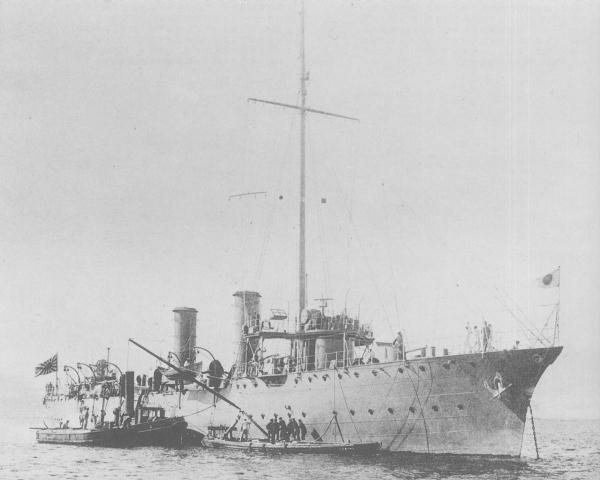
The IJN Yodo and IJN Mikuma, built quickly (1906-1908 for the first, 1907-1908 for the second), were small fast scouts/dispatch vessels. The emergence of radio-telegraphy and its rapid generalization made them obsolete overnight. They differed in terms of both propulsion and appearance, the Yodo had conventional engines, two funnels and a clipper bow, and the Mogami, first to to adopt a turbine and three propellers. She had three funnels and a straight bow and stern.
However, their dimensions and tonnage were the same, almost, Mogami being heavier by 100 tonnes, 3 meters longer and faster than a knot. Because of their modest size, they were reclassified as gunboats in 1912. IJN Mogami did not give any satisfaction since she was scrapped in 1928 and broken up three years later, while IJN Yodo became a patrol ship from 1927, a role which lasted until 1940. In 1945 she was still in reserve.
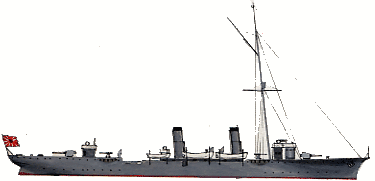
Author’s rendition of the Yodo class
Specifications
Displacement & Dimensions 1250t PC; 93 x 9.8 x 3 m
Propulsion 2 propellers, 4 cylinders, 4 Miyabara boilers, 6500 hp. and 22 knots max.
shielding, max. 63 mm; Crew 180
Armament 2 guns of 120, 4 of 45 mm, 2 TLT flanks.
Tenryu class (1919)
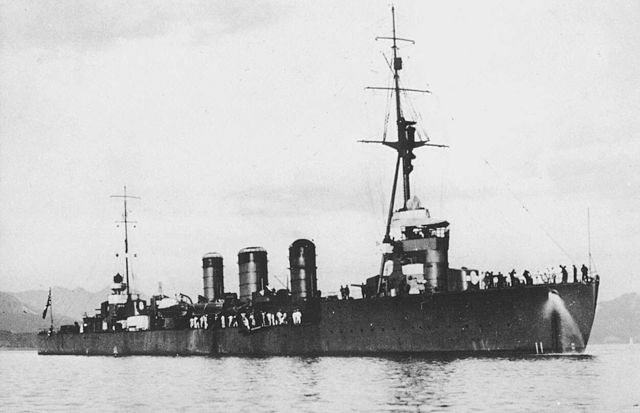
If the great cruisers of the Kuma, Nagara and Sendai class are better known, they are an evolution of these precursors, built during the Great War. Indeed, the Tenryu and the Tatsuta were defined by the admiralty in 1916 which wanted a kind of “super-destroyer” based on the British design of the Arethusa and “C”. Both were victims of US submarine torpedoes.
Under the name of project 33, they were put on hold in 1917 two months apart at the Yokosuka and Sasebo shipyards. They had been defined as squadron leaders capable of 33 knots. They also received the new 140 mm guns which equipped the two battleships of the Ise class. They were also the first to benefit from triple banks of torpedo tubes.
During their long working career (they were launched in 1918 and completed in 1919), they received a more robust tripod mast. Originally, their AA was ensured by a single 78 mm mount, replaced in 1941, after being supported by two 13.2 mm machine guns in 1939, by 5 twin mount 25 mm.
Re-rated as second class cruisers they had a pole foremast replaced by a tripod in 1930-31, plus two 13.2mm AA added in 1939, but no true modernisation. IJN Tatsuta kept her 78 mm on the rear deck, however. During the war, they mainly carried out escorts. Tenryu met her fate on December 18, 1942 by the Gato-class submarine USS Albacore. Tatsuta survived until April 1944, to be torpedoed and sunk in turn by USS Sandlance.
Specifications
Displacement 3,948 t. standard -4,350 t. Full Load
Dimensions 142.9 m long, 12.3 m wide, 4 m draft
Machines 3 propellers, 3 turbines, 10 mixed boilers, 51,000 hp.
Maximum speed 33 knots
Armor From 51 (belt) to 25 mm (Bridge)
Armament 4 guns of 140 mm (4 × 1), 1 gun of 78 mm, 8 of 25 mm AA, 2 mitt. 13.2 mm AA, 6 TLT 610 mm (2 × 3)
Crew 340
Kuma class (1919)
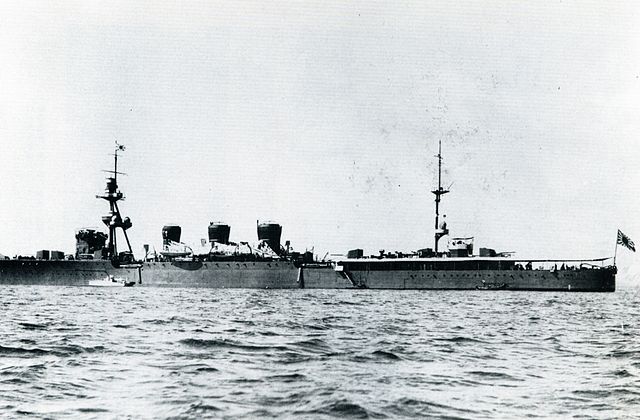
The 6 cruisers of the Kuma class, of the great armament plan of 1916, entered service too late to participate in the conflict, the last in 1921. They were enlarged versions of the two Tenryu, with reinforced armament of 3 pieces 140 mm, they were more powerful and faster, but with a displacement of 1500 tonnes greater. They were a compromise between light cruisers and scouting vessels.
The class included the Kuma, Tama, Kitakami, Oi and Kiso. The Kuma and the Tama received seaplanes and a catapult in 1934-35, their rear mast became tripod, the hull was reinforced, the Kitakami seeing its front chimney raised while the others were grafted with different chimney heads. Their forward mast superstructures were enlarged. These ship’s AA received four 25 mm twin mounts in 1938-39, and their torpedo tubes increased to 610 mm instead of the initial 533. The displacement thus climbed 200 tonnes, their speed, initially from 36 knots fell to 33.
A flying-off platform for an aircraft was installed forward in 1927, with a hangar in the bridge. Platforms were removed about 1935, when Kuma and Tama were fitted with a tripod mainmast, and a catapult for an aircraft between Nos 5 and 6 5.5in guns. Eight 24in TT replaced the original 21in TT in 1940. In 1941, Kitakami and Oi were rebuilt as torpedo cruisers, in a most unusual conversion. Nos 5,6 and 75.5in guns were removed; 200ft sponsons, extending from the first funnel to the mainmast, increased overall beam from 47ft 3in (14.4m) to 57ft 3in (17.45m), and supported ten quadruple 24in TT, easily the heaviest torpedo battery ever mounted afloat.
Data became: displacement 5870t standard, and armament 4-5.Sin/50 (4×1), 8-25mm AA, 40-24in TT (10×4). Oi was further rearmed in 1943, the remaining 5.5in guns being replaced by 4-Sin/40 DP (2×2, fore and aft), and 28-25mm AA being added. Torpedo cruisers became doubtful bargains as the possibility of a fleet action faded after Midway, so in 1942-43 Kitakami was converted into a fast transport, with armament 4-5in/40 DP (2×2), 18-25mm AA, 8-24in TT (2x 4), and 6(?) 14m Daihatsu landing craft. In January 1944 she was hit in the aft engine room by a British submarine torpedo, and was rebuilt as a Kaiten (suicide submarine) carrier; data was then: displacement 5640t standard, 6960t trial, armament 4 x 5in/40 DP (2×2),67-25mm AA, 8 Kaiten, 18 DCs, and performance with the two turbines and two shafts remaining 35,000shp 23kts. Nos 5 and 7 5-in guns in Tama and Kiso were replaced by 2-5in/40 DP (1×2) in July 1944, when light AA armament was increased to 44-25mm and 6-13.2mm.
Kumu was sunk by torpedoes from the British submarine Tally Ho off Penang; Tama, damaged in the Battle of Cape Engano, was finished off by torpedoes from the US submarine Balao, Kitakami was used postwar as a red cross ship for repatriation transports before being scrapped. Oi was torpedoed and sunk by the US submarine Flasher, whereas Kiso was a victim of US aircraft in Manila Bay.
Following the very aggressive naval tactics in vogue at the time, the Oi and the Kitakami ferret converted into torpedo cruisers, an old concept fallen into oblivion and refreshed with these versions equipped with 10 quadruple benches of torpedo tubes (40 in total), mounted on lateral hull extensions 60 meters long and losing their main artillery. They returned to service in December 1941. The Kitakami won two additional 25 mm double carriages, as well as two twin 127 mm AA turrets, and in 1943 lost four torpedo banks.
Severely damaged by the English submarine HMS Templar in 1944, they will be rebuilt in transport of Kaiten, losing part of her machines, replaced by a hold, it was adapted a crane and a workshop for these piloted torpedoes, from which she could take 8 units. She survived the war and was BU in 1947, while the Oi was sunk in July 1944, the Kiso in November 1944, the Tama in October 1944, Kuma in January 1944.

IJN Kitakami in WW2
Specifications
Displacement 5,650 t. standard -6,200 t. Full Load
Dimensions: 158.6 m long, 14.2 m wide, 4.8 m draft
Machinery: 2 propellers, 4 Gihon turbines, 12 Kampon boilers, 90,000 hp.
Top speed: 32 knots
Armor: From 32 to 62 mm
Armament: 7 x 140 mm, 4 x 25 mm AA guns, 8 x 610 mm TTs (4 × 2)
Crew: 450
Nagara class (1921)
Nagara, Isuzu, Natori, Yuru, Kinu, Abukuma
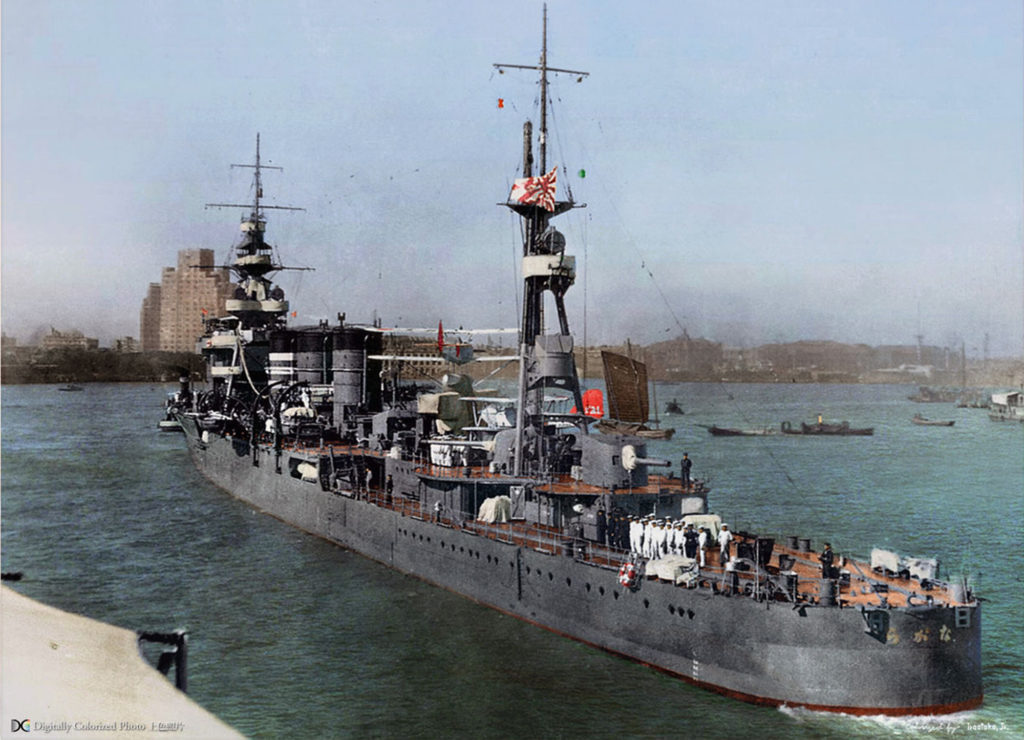
Although it is a bit off-topic as these ships were launched in the 1920s, not only they were planned in 1918, but the blueprints derived from those of previous cruisers, going back to 1917.
Nagara was the first ship in the Japanese Navy to carry 24in torpedo tubes. The last three ships were named Suzuka, Otonase and Minase until November 1921. All the ships of this class had fixed flying-off platforms over their Nos 1 and 2 gun mounts, forward of their bridges, with hangars in their bridgework, as in contemporary British cruisers.
As a result, they had tall slab-sided forward superstructures even after the removal of the flying-off platforms. It appears that the platforms were never used. On trials, Natori made 91,100shp
34.94kts at 5532t. Abukuma collided with Kitakami on 20 October 1930 and was fitted with a yacht-type bow, like that of Naka in the next class at Kure. Catapults (15 metre powder type) were installed on the take-off platforms of Yura (1929) and Kinu (1931), and Jintsu (1930). They were removed after accidents during trials, and the decision made to mount revolving catapults aft in these and the other 5500-ton cruisers.
The standard refit involved installation of the catapult and also fitting of a tripod mainmast. Dates of refit: Nagara (October 1932-September 1933), Isusu (May 1932-1933), Natori (July 1931-September 1932), Kinu (November 1933-August 1934). In Nagara, Isuzu and Abukuma the take-off platform was removed in refit, and quad 13mm fitted forward of the bridge. In the others, the take-off platform was removed later (1936 in Natori and Kinu); they too received the 13 mm mount after During a second refit (April 1937-February 1938).
This class was completed with a flying-off platform forward and a hangar in the bridge, but no aircraft was carried (except briefly by Yura and Abukuma in 1926-27) until a catapult was added to the platform in about 1927. Abukuma was repaired with a bow like Naka’s after colliding with Kitakami in 1930. Between 1931 and 1936 the pole mainmast was replaced by a tripod, and the catapult
moved aft, between nos 5 and 6 5.5in guns. In 1943, nos 5 and 7 5.5in guns were replaced by 2-5in/40 DP (1×2), when the light AA armament was augmented to 22-25mm and 2-13.2mm; the torpedo battery was reportedly increased to 24-24in TT. Two twin 25mm replaced the two 3.lin AA in 1938. By 1938 maximum speed had fallen to 34.5kts.
Abukuma was altered as flagship of destroyer squadrons trained for night attacks. During World War Two Isuzu was converted into an anti-aircraft cruiser, armed (March 1944) with 3 twin 12.7mm, 11 triple and 6 single 25mm AA machine guns. The other ships all had 2-5.5in replaced by 1 twin 5in AA mount. As of March 1944 light AA batterieswere: Nagara 2 triple 25mm, 2 twin 25mm, 4 single 25mm, 1 quad 13mm; Natori 4 triple and 2 twin 25mm, 1 quad 13mm; Kinu 2 triple and 2 twin 25mm, 1 quad 13mm; Abukuma 4 triple and 2 twin 25mm and 1 quad 13mm. Batteries were very rapidly augmented after that. As of July 1944:
Nagara 2 triple, 6 twin, 14 single 25mm (32), 1 twin, 8 single 13mm; Isuzu 11 triple, 5 single 25mm (38), no 13mm; Abukuma 4 triple, 2 twin, 14 single 25mm (30), 1 twin, 5 single 13mm MG.
The displacement of the surviving units increased to 6050t by June 1944, with 36-25mm AA and speed reduced to 33.4kts. Isuzu was re-armed as an anti-aircraft cruiser in 1944, with an armament of 6-5in/40 DP (3×2), 38-25mm AA, 8-24in TT (4×2). All were war losses. Three were sunk by US submarine torpedoes: Nagara (sunk by Croaker), Isuzu (Charr and Gabilan), and Natori (Hardhead). Yuru,
crippled by Marine aircraft off Guadalcanal, was sunk by Japanese destroyers, whereas Kinu and Abukuma were despatched by US aircraft in the retreat from the Leyte Gulf Battle.
Specifications
Displacement: 5,570 t. standard -7,200 t. Full Load
Dimensions: 162.1 m long, 14.2 m wide, 4.8 m draft
Machines: 2 shafts, 4 turbines, 12 boilers, 90,000 hp.
Maximum speed: 36 knots
Armor: From 28 to 65 mm
Armament: 7 x 140mm (7 × 1), 2 x 76mm, 2 x 13.2 mm AA, 8 x 610 mm (4 × 2) TTs, 1 plane, 80 mines
Crew: 450
Sendai class (1921)
Sendai, Naka, Jintsu, Kako (cancelled)
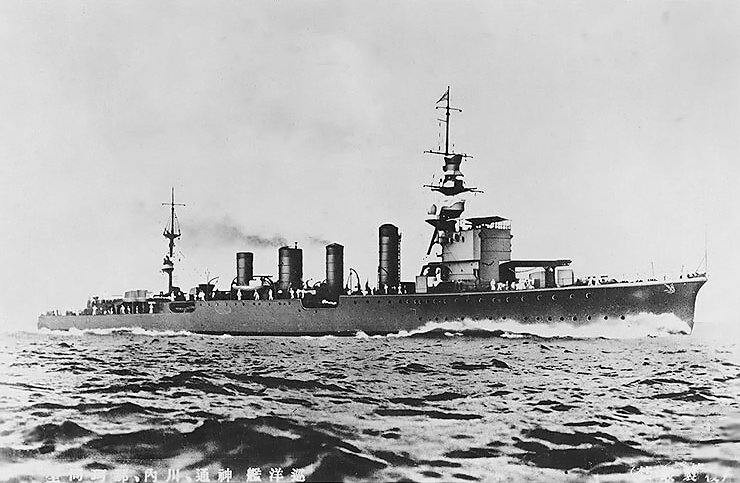
These cruisers as off-topic but reported there since they inherited from previous ones, going back to the Kuma class in 1918. They were the last of this kind, with single main guns under masks, narrow beam and numerous funnels. The 1920s Furutaka and following were started with the Washington treaty in mind and completely new animals.
The four Sendai class cruisers were very close in design to the previous Nagara, but with larger dimensions, new machines increasing speed and adding a tall funnel to their profile. The class’s fourth cruiser, the Kako, was struck off due to compliance with the tonnage imposed by the Washington Treaty. IJN Kako awa laid down on 15 February 1922 but cancelled on 17 March, as the Washington treaty was signed.
The three units received in 1929 a catapult for a reconnaissance seaplane, and in 1943, they received a powerful AA, their 3-inAA guns being replaced by new 5-in (127 mm) guns and reinforced with forty-four 25 mm and six 13.2 mm heavy machine guns (0.5 in).
They were all sunk by acts of war, IJN Naka in February 1944 in Truk naval base in the Carolinas, by squadrons of B-25 Mitchell “Gunship”. Sendai, badly damaged during the battle of the bay of Empress Augusta, will be given the coup de grace by American TBM Avengers. Finally the Jintsu participated in the battle of Kolombangara, and was destroyed by light American cruisers of the Omaha class gunfire and several destroyers.

Author’s rendition of the Sendai class (1/400) as modernized in the intwerwar
Specifications
Displacement 5,200 t. standard -7,100 t. Full Load
Dimensions 163 m long, 14.17 m wide, 5 m draft
Machines 2 propellers, 4 turbines, 12 boilers, 90,000 hp.
Maximum speed 35.2 knots
Armor From 28 to 65 mm
Armament 7 x 140mm (7 × 1), 2 x 76mm, 2 x 13.2 mm AA, 8 x 610 mm (4 × 2) TTs, 1 plane, 80 mines
Crew 450
Japanese Battlecruisers
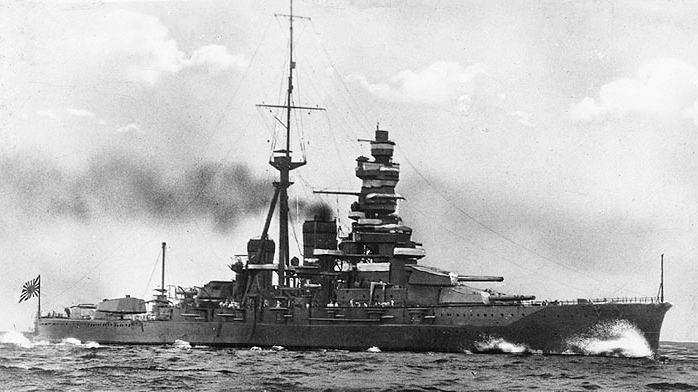
The Imperial Japanese staff embarked on the same bandwagon as the Royal Navy. There is much dispute among historians to nail the first Japanese “battlecruiser”. The term is generally applied today to the sole Kongo class, whereas the Ibuki class, is considered a “semi-battlecruiser” in the same way the Satsuma class were still pre-dreadnoughts but very much considered as “semi-dreadnoughts”, in short, transitional vessel.
Kongo class battlecruisers
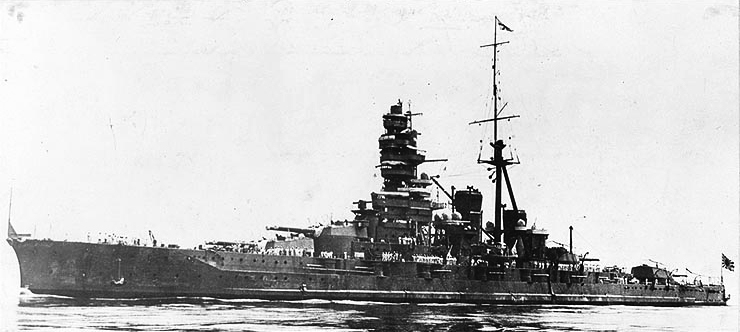
The IJN Kongo, Haruna, Hiei and Kirishima were four formidable capital ships commissioned from Great Britain in 1910, and launched in 1912 and 1913. They were completed just before the start of the Great War, which was fortunate as they could have been requisitioned. Their design was based on the HMS Tiger, they demonstrated that the Japanese admiralty had decided to move further the scale of the IJN, confirming its aspiring dominant place in Asia.
The British admiralty certainly did not expect to find them one day in front of them. They served widely in the Pacific, demonstrating their relevance by being very effective in the role of “touts” of the German fleet of the Pacific (Graf Von Spee) towards the British squadron in 1914. The front was calm, and their career was without stories, from assignments to assignments. In 1919, they were going to undergo a short overhaul and modernization, but the main one intervened in 1927-29, at the end of which they became fast battleships, the first of the Japanese navy.
Specifications
Displacement & Dimensions 27,500-31,000t; 204.70 x 27 x 8.2 m
Propulsion 4 propellers, 4 Brown-Curtis turbines, 24 Miyabara boilers, 40,000 hp. and 27 knots max.
Armor, Pont 50 crew, blockhouse 230, belt 210, turrets, 305 and 150, barbettes 152; Crew 1210
Armament 8 guns of 356, 16 of 152, 4 of 78 mm AA, 6 TLT 533 mm SM.
Armament of IJN cruisers
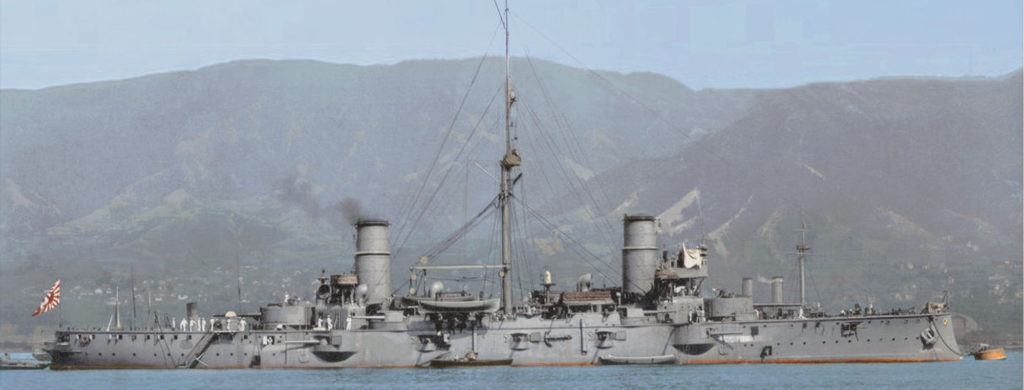
IJN Nisshin (colorized)
In 1902 as the Anglo-Japanese alliance was signed, conformity with British armament went in greater depths while at the same time, British companies and the government were more lenient towards licence production patterns. Armstrong and Elswick guns represented the basis of all IJN cruisers artillery, from battlecruiser to scouts, and armored cruisers. This ranged from 12-in for the Kongo-class (not speaking of 1919 projects with 21-in guns !) to 12 pounders. The second supplier at much smaller scale, was for light guns, the French Company Hotchkiss. Even the Italian-built Garibaldi class had British/Orlando guns. The Japanese used a complete panoply of 10-in, 8-in, 6-in, 4.7-in, 3-in, 12, 9, 6, 3 and 1-pdr QF guns and Maxim MGs.
French weaponry was used IJN Unebi, Matsuhima-class protected cruisers: 12.6 in (320 mm), 9.4 in (238 mm), 5.9 and 4.7 in. Unebi and Matsushima were lost, the remainder were rearmed later. French-built IJN Chishima (1890) had British guns. The pattern was reproduced with the more recent IJN Yakumo (Built in Vulcan, Stettin, Germany) and Adzuma (built in st Nazaire, france). Both had the same quatuor of 8-in, twelve 6-in, twelve 12-pdr and a varied lighter armament, 3-pdr or 2-1/2 pdr guns.
The fleet also captured the Chinese cruiser Sai Yen, armed with Krupp guns, notably 8.2 in (208 mm) main guns, also rearmed.
Probably the most “exotic” of these calibers was 10.3 (260 mm) and 5.9 in guns (149 mm) for IJN Naniwa (1885), Swedish Nordenfelt guns and US Gatling MGs.
Torpedo tubes ranged from 12-in (305 mm) for Naniwa up to 24 in (610 mm) on the Nagara and Sendai classes, for the exceptional Type 93 torpedo. In between, the 18-in model was the most common (457 mm) before 1908; 21-in (533 mm) after.
Naval aviation only started in 1920-22 also with the Nagara and Sendai classes, the first fitted with permanent catapults, but like in the Royal Navy, platforms were installed for small fighters to take off. Their role was to down enemy observation planes, spotting and reconnaissance.

IJN Itsukushima colorized by Irootoko jr.
8-in guns
-8″/45 (20.3 cm) EOC Pattern S/U/U1/W 41st Year Type (1904)
This heavy gun had an interesting history: The base model originated in Elswick Factory, used on Ansaldo’s Armored Cruisers. They were near-clones of the 8″/45 (20.3 cm) Ansaldo model. Japan acquired the licence and thus, the 8″ (20.3 cm) 41st Year Type was born, based on Armstrongs blueprints and patents. Author’s does not agree on the caliber, either 40 or 45 calibers like coastal models. Apparently the guns wear out rather quickly, as shown by IJN Nisshin at Tsushima had three guns disabled as prematurly worn out. These guns were used on IJN Adzuma, Asama, Iwate, Izumo, Kasuga, Nisshin, Tokiwa and Yakumo armored cruisers and Chikuma scout cruisers.
In 1922 with limitations, the guns were dismounted and recycled in coastal batteries. Tokyo Bay, Tarawa and Wake later.
Caracteristics
-Partial wire wound, screw breech blocks.
-Weight 18.45-19.1 tons, barrel 373.5 in/360 in
-2 rpm, AP: 250 lbs. (113.4 kg) AP shell, bag 57 lbs. (25.85 kg).
-Muzzle velocity 2,480 fps (756 mps)
6-in guns
41st Year Type 15 cm/45 (6″)
Also called 6″/45 (15.2 cm) Elswick, this was the standard light cruiser gun. It was adopted in Japan, imported from UK, and redesignated 41st Year Type on 25 December 1908. It entered service in 1910 and was used in Tone and Chikuma.
Caracteristics:
-270 in (6.858 m) barrelfiring a 100 lbs. (45.4 kg) HE/AP shell
-5 rpm, mv 2,707 fps (825 mps), range 16,190 yards (14,800 m)
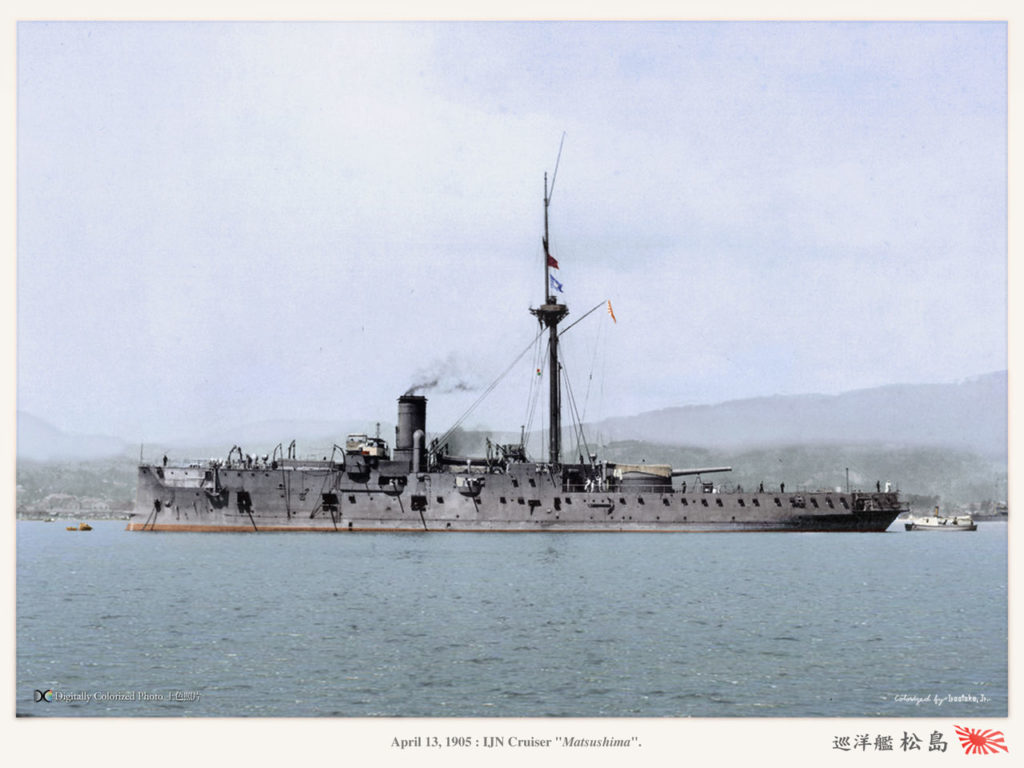
IJN Matsushima colorized by Irootoko jr.
5.5-in guns
3rd Year Type 14 cm Gun/40
Called 5.5″/50 (14 cm) 3rd Year Type, it was built in Japan and became the most common standard secondary gun in the Imperial Japanese Navy froml 1914 to 1922. Understandably it was still in service in WW2 in many places, in addition to ships. Production ceased in 1930.
Contrary to the former British model it was designed from, it fired lighter shells, thus was better suited for manual handling for the average Japanese man. It used four layers plus a wire-winding to assemle the barrel, and without the wire later. The gun also used the Welin screw breech-block. It was used on the light Cruisers classes Tenryû, Kuma, Nagara, Sendai, Yubari and Katori, the seaplane carrier Nisshin, the aircraft carrier Hosho, seaplane tender Okinoshima.
Caracteristics:
-Weight 5.5/5.6 tons, barrel lenght 275.6 in (7.000 m)
-Rpm 6-10, projectile 83.8 lbs. (38.0 kg) and 4.4 lbs. (2.0 kg) charge standard
-Muzzle velocity: 2,789 to 2,805 fps (850 to 855 mps)
-Pressure 18.4 to 18.5 tons/in2, wear 500 – 600 Rounds.

IJN Chiyoda colorized by Irootoko jr.
4.7″/40 (12 cm) Type 41
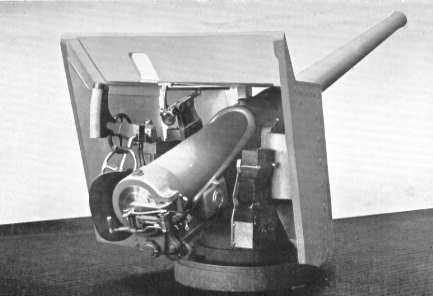
This model was derived from the British 4.7-inch (12 cm) QF Marks I to IV, and the Italian 120 mm Model 1889, 1891 and 1893. In Japan, the first were imported from Elswick, and later replicated with Patents in Japan, the last model called 12 cm/40 (4.7″) 41st Year Type (Model 1908).
Trials of the second serie (it entered service in 1885) went on the HMS Trafalgar in the early 1890s, showing the amazing performance of 7 rounds a minute. It became the fastest non-automatic gun wordlwide.
Elswick own copy of the Armstrong gun was sold to Japan which obtained a license and ironically, 37 of them were returned back to Britain during World War I. Japanese guns were redesignated as 41st Year Type on 25 December 1908. Redesignated in centimeters on 5 October 1917.
It was used on Japanese Cruisers and destroyers of the early 1900s.
The average volume was 284 in3 (4.66 dm3),
rpm (aimed shots) 5-6 rounds per minute
-Fired AP, HE, CP, Shrapnel (45 lbs. (20.4 kg)) shells.
-Muzzle velocity: 2,182 fps (660 mps)
12-pdr guns
Called in UK 12-pdr [3″/40 (7.62 cm)] and 12cwt QF Marks I, II, V. This light gun was aso used by Italy as the 76.2 mm/40 (3″) Ansaldo 1916/1917.
The Japanese model was the 3″/40 (7.62 cm) 41st Year Type.
6.5 mm/115 3rd Year Type
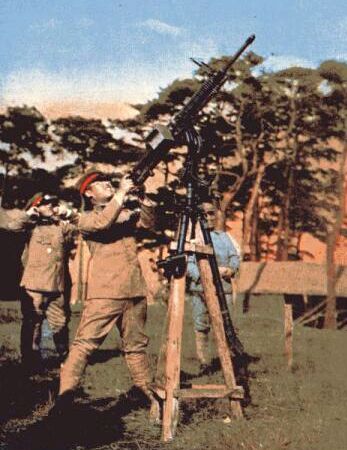
The French/American Hotchkiss 6.5 mm Model 1900 machine gunwas demonstrated to Japanese officers which purchased it prior to the Russo-Japanese war, where it proved very efficient. The Japanese declined their own version for the Army, adopted in 1914 as Type 3 Kikanhô. The Navy followed on 6 December 1916 and redesignated it the 3rd Year Type 6.5-mm Kihô. It was used as the primary AA weapon on all ships from 1917 in the interwar and saw extensive service during WW2.
The Japanese version modified ejector mechanism was reworked and additional barrel fins for faster cooling. The bore was reworked to accept also the standard 6.5 mm Japanese rifle cartridge, and it came with 30 rounds metal strips. The Army however found it quite heavy, whereas the Navy found it strong and reliable, despite the oiling of the cartridges. It was declined into a 12.7 mm and served as a basis for a 37 mm AA gun, which became common in IJN warships.
IJN cruisers in action
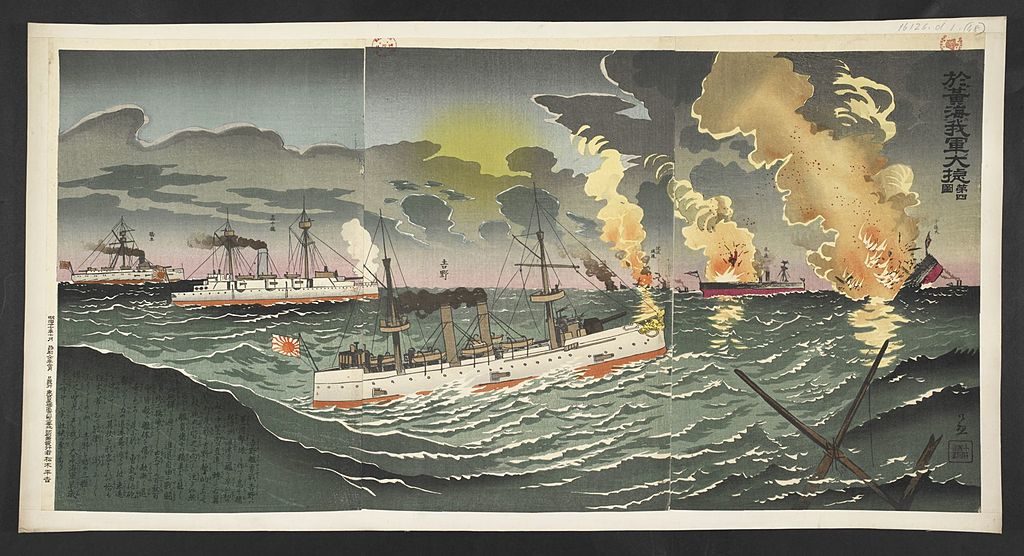
The Battle of Yalu & Yellow sea (1894):
At the start of the Sino-Japanese war, the IJN only comprised cruisers, whereas the Beiyang fleet was the most powerful combined fleet in the whole of Asia, including two German-Built battleships of the Dingyuan class. Despite of this, the IJN combined fleet was to engage the bulk of it, allowing transports to land troops in Korea. The first engagement only involved IJN Akitsushima, Yoshino and Naniwa and was a clear win off Pungdo Island.
The complete flying squadron was composed of four fast cruisers: Yoshino, Takachiho, Akitsushima, and Naniwa. The main fleet comprised IJN Matsushima (flagship), Chiyoda, Itsukushima, Hashidate and two old ironclads. Basically the faster and more agile Japanese cruisers ran circles around Ding Ruchang’s fleet and by skirmishing constantly, ended by sinking the bulk of it, capturing later at Port Arthur one the two crippled ironclads and two cruisers. The battle was settled with traditional broadside naval gunfire delivered from a line ahead formation. The Japanese heavy canet guns malfunctions and never fired a shot.
The Battle of Yellow sea & Tsushima (1905):
https://youtu.be/-WOCnmh5Dg4
Extract from 日本海大海戦 特撮戦闘場面 (1969’s Nihonkai daikaisen)
By that time, barely ten years after Korea, the IJN was a considerably larger fleet, several time its previous tonnage, and including several battleships. It was requitred to face one of the strongest navy at the time, from Imperial Russia.
The battle of 10 August 1904 saw the Russian Pacific Fleet trying to exit Port Arthur and run to Vladivostok, but the attempt was fouled with heavy losses, on bth part mainly attributed to mines.
The Japanese combined fleet comprised no less than 4 armoured cruisers and 8 protected cruisers. The armoured cruisers Nisshin and Kasuga, and the eight protected cruisers sailed woth Togo’s main fleet, whereas admiral Dewa’s reserve squadron comprised the older Chitose, Takasago, Yakumo or Kasagi and Yoshino arriving from the south. Togo tried to have these two columns trapping Admiral Vitgeft’s fleet.
But manoeuvers failed and the combat degenerated into a “chase the tail” sort. Dewa’s squadron was the closest and Yakumo was badly hit from a range of over 8 miles, forcing Togo to order their retreat. They would take no further role i the battle. However Togo’s own armoured cruisers took the line. It was a fair match between Admirals Tōgō and Stark but ultimately the first prevailed. The battle was more studied for its pre-dreadnought engagement showing a more modern rangefinder could do wonders, and that armoured cruisers could perform their fair share of action in a battle line.
At Tsushima, the same forced met the Baltic squadron, arriving with worn-out ships and tired crew from a very long trip. There was a contested day action between the two battlelines and fierce night attacks, moslty performed by destroyers. On the Japanese side, the most battle-damaged were the Italian-built Kasuga and Nisshin, which took part in the fight between battleships and impressed their crews by their resilience. Only Nisshin took damage, loosing three light guns and about 50 crew injured (Shamefur Dispray! Commit Sudoku!). For cruiser-to cruiser engagements, the Russian lost four cruisers out of height, with the others later captured but Dmitrii Donskoi in the end proved a though nut to crack, duelling alone against the six Japanese cruisers at once and surviving to tell the story.
World war one:
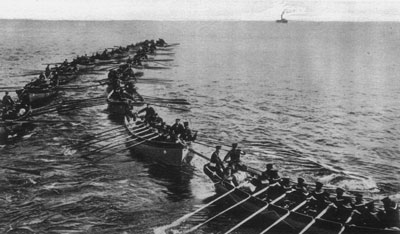
Due to the gross discrepancy between respective naval forces, the tiny German Pacific squadron could not hope to take its chances against the mighty IJN. The first time guns were blazing, cruisers included, was during the siege of Tsingtau. For the remainder of the war, IJN cruisers limited their service to patrols and exercises.
Read More
Robert Gardiner Conway’s all the world’s fighting ships 1865-1905
Robert Gardiner Conway’s all the world’s fighting ships 1906-1921
Jentsura, Hansgeorg (1976) Warships of the Imperial Japanese Navy, 1869-1945.
Nishida, Hiroshi. “Materials of IJN”. Imperial Japanese Navy
Howarth, Stephen (1983). The Fighting Ships of the Rising Sun: IJN 1895-1945.
Jentsura, Hansgeorg (1976). Warships of the Imperial Japanese Navy, 1869-1945. Annapolis, MD: Naval Institute Press. ISBN 0-87021-893-X.
Roberts, John (ed). (1983). Warships of the world from 1860 to 1905 – Volume 2
Roksund, Arne (2007). The Jeune École: The Strategy of the Weak.
Schencking, J. Charles (2005). Amergence of the IJN 1868-1922
//www.navypedia.org/ships/japan/jap_cruisers.htm
//www.fr.naval-encyclopedia.com/1ere-guerre-mondiale/navires-japonais1914.php#crois
//www.hazegray.org/navhist/cruisers/
//www.navweaps.com/Weapons/WNJAP_Main.php
en.wikipedia.org/wiki/List_of_cruiser_classes_of_the_Imperial_Japanese_Navy
Models corner:
Kombrig 1/700 1880-1900 IJN cruisers
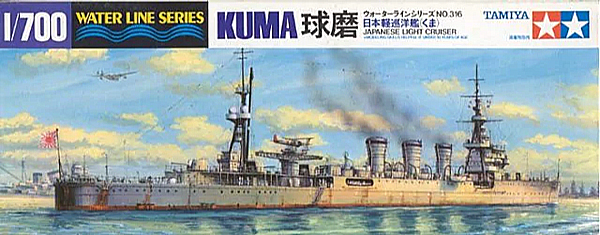
Navis Neptun 1/1250 IJN Tatsuta, Tama, Kitakami
Tamiya 1/350 Tone
Tamiya 1/700 waterline series: Kuma, Tama, Kiso, Natori, Kinu, Nagara, Isuzu, Abukuma
3D corner:
Sketchfab models:
IJN Tenryu
IJN Kuma
IJN Iwaki


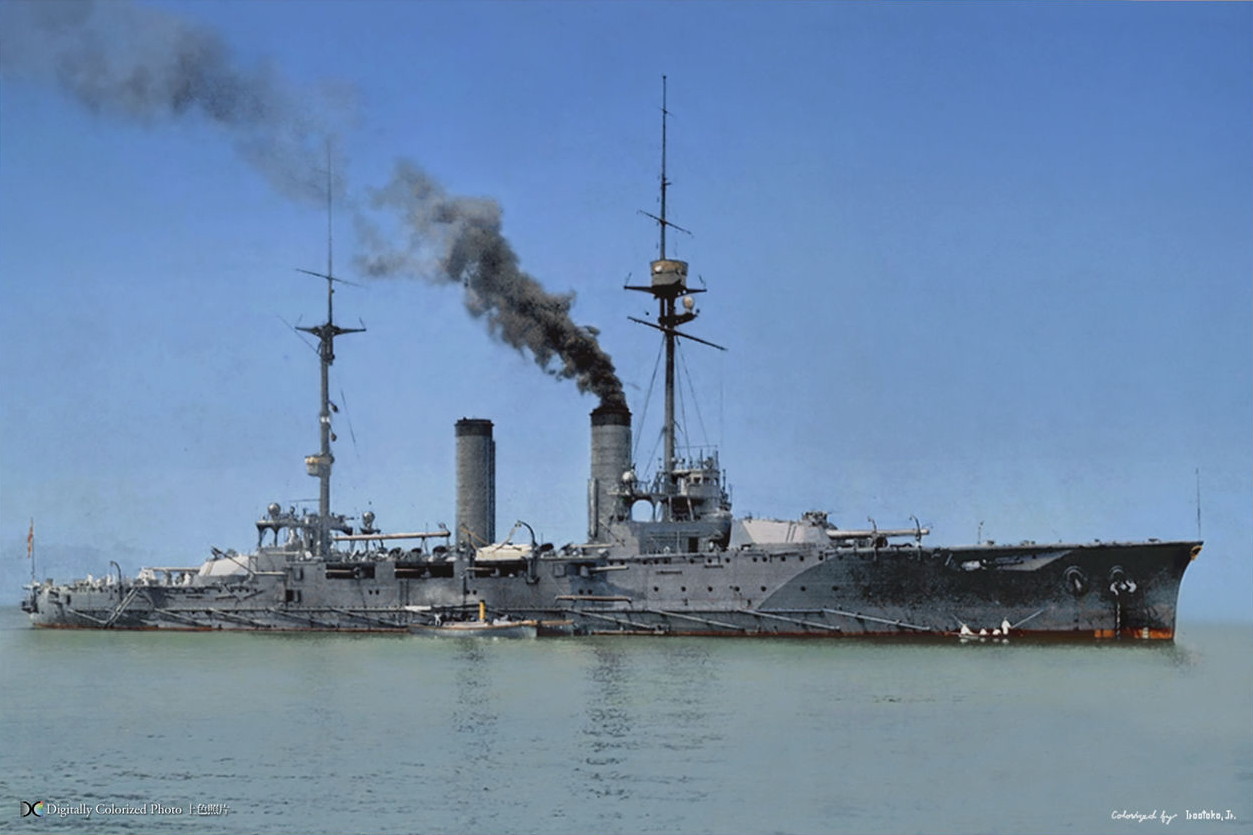
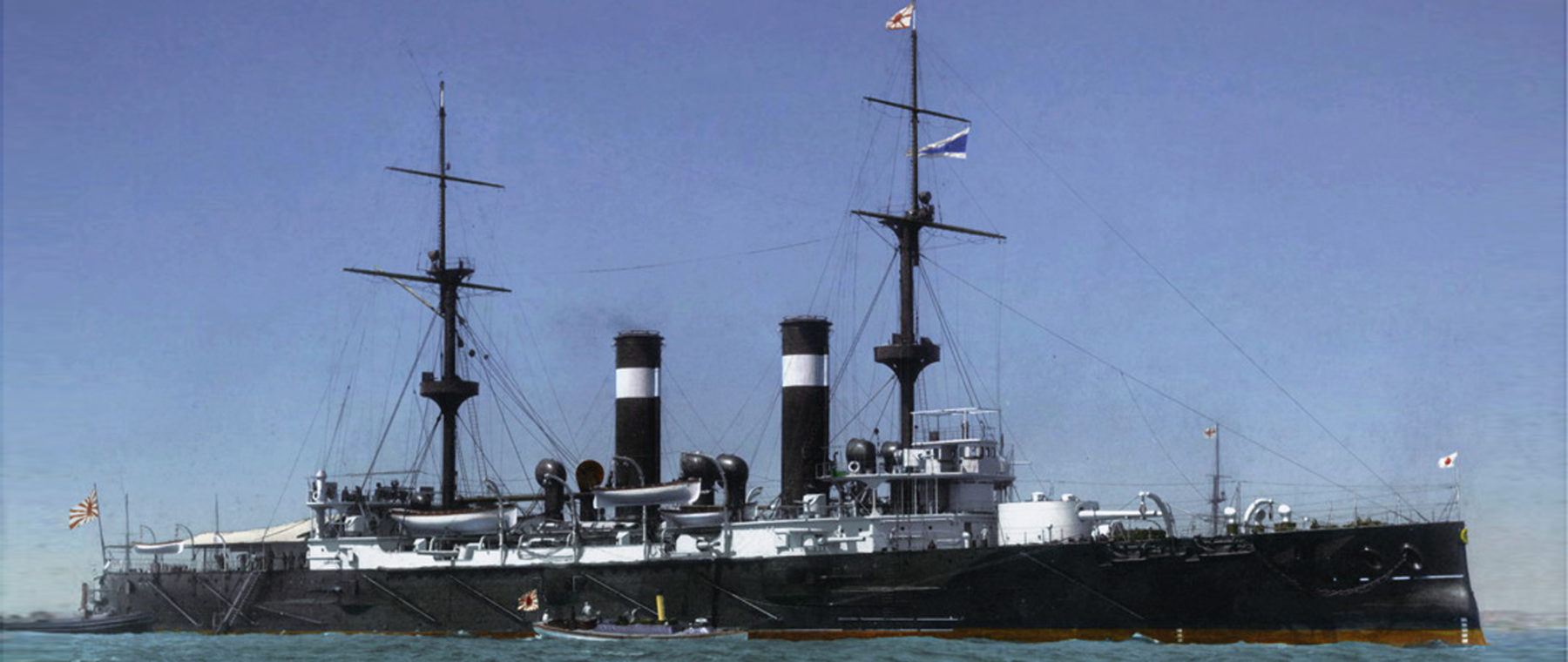
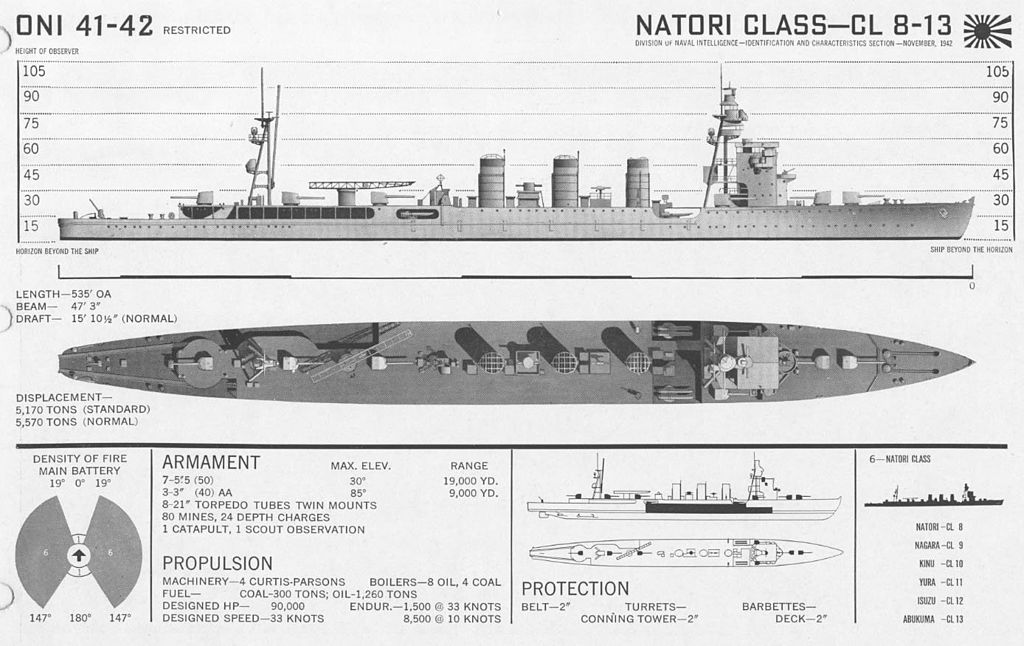
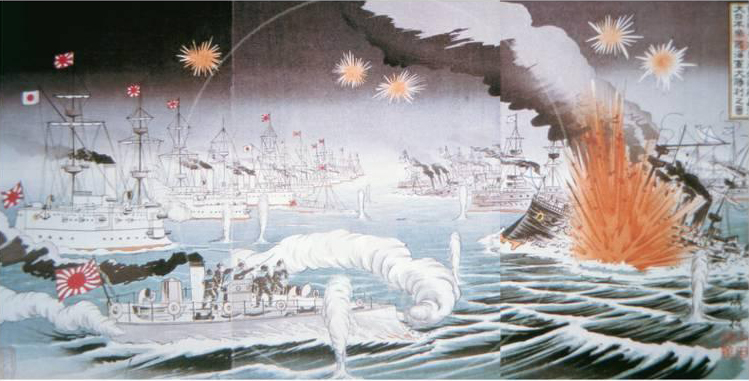
 Latest Facebook Entry -
Latest Facebook Entry -  X(Tweeter) Naval Encyclopedia's deck archive
X(Tweeter) Naval Encyclopedia's deck archive Instagram (@navalencyc)
Instagram (@navalencyc)





 French Navy
French Navy Royal Navy
Royal Navy Russian Navy
Russian Navy Armada Espanola
Armada Espanola Austrian Navy
Austrian Navy K.u.K. Kriegsmarine
K.u.K. Kriegsmarine Dansk Marine
Dansk Marine Nautiko Hellenon
Nautiko Hellenon Koninklije Marine 1870
Koninklije Marine 1870 Marinha do Brasil
Marinha do Brasil Osmanlı Donanması
Osmanlı Donanması Marina Do Peru
Marina Do Peru Marinha do Portugal
Marinha do Portugal Regia Marina 1870
Regia Marina 1870 Nihhon Kaigun 1870
Nihhon Kaigun 1870 Preußische Marine 1870
Preußische Marine 1870 Russkiy Flot 1870
Russkiy Flot 1870 Svenska marinen
Svenska marinen Søværnet
Søværnet Union Navy
Union Navy Confederate Navy
Confederate Navy Armada de Argentina
Armada de Argentina Imperial Chinese Navy
Imperial Chinese Navy Marinha do Portugal
Marinha do Portugal Mexico
Mexico Kaiserliche Marine
Kaiserliche Marine 1898 US Navy
1898 US Navy Sovietskiy Flot
Sovietskiy Flot Royal Canadian Navy
Royal Canadian Navy Royal Australian Navy
Royal Australian Navy RNZN Fleet
RNZN Fleet Chinese Navy 1937
Chinese Navy 1937 Kriegsmarine
Kriegsmarine Chilean Navy
Chilean Navy Danish Navy
Danish Navy Finnish Navy
Finnish Navy Hellenic Navy
Hellenic Navy Polish Navy
Polish Navy Romanian Navy
Romanian Navy Turkish Navy
Turkish Navy Royal Yugoslav Navy
Royal Yugoslav Navy Royal Thai Navy
Royal Thai Navy Minor Navies
Minor Navies Albania
Albania Austria
Austria Belgium
Belgium Columbia
Columbia Costa Rica
Costa Rica Cuba
Cuba Czechoslovakia
Czechoslovakia Dominican Republic
Dominican Republic Haiti
Haiti Hungary
Hungary Honduras
Honduras Estonia
Estonia Iceland
Iceland Eire
Eire Equador
Equador Iran
Iran Iraq
Iraq Latvia
Latvia Liberia
Liberia Lithuania
Lithuania Mandchukuo
Mandchukuo Morocco
Morocco Nicaragua
Nicaragua Persia
Persia San Salvador
San Salvador Sarawak
Sarawak Uruguay
Uruguay Venezuela
Venezuela Zanzibar
Zanzibar Warsaw Pact Navies
Warsaw Pact Navies Bulgaria
Bulgaria Hungary
Hungary

 Bundesmarine
Bundesmarine Dutch Navy
Dutch Navy Hellenic Navy
Hellenic Navy Marina Militare
Marina Militare Yugoslav Navy
Yugoslav Navy Chinese Navy
Chinese Navy Indian Navy
Indian Navy Indonesian Navy
Indonesian Navy JMSDF
JMSDF North Korean Navy
North Korean Navy Pakistani Navy
Pakistani Navy Philippines Navy
Philippines Navy ROKN
ROKN Rep. of Singapore Navy
Rep. of Singapore Navy Taiwanese Navy
Taiwanese Navy IDF Navy
IDF Navy Saudi Navy
Saudi Navy Royal New Zealand Navy
Royal New Zealand Navy Egyptian Navy
Egyptian Navy South African Navy
South African Navy






























 Ukrainian Navy
Ukrainian Navy dbodesign
dbodesign